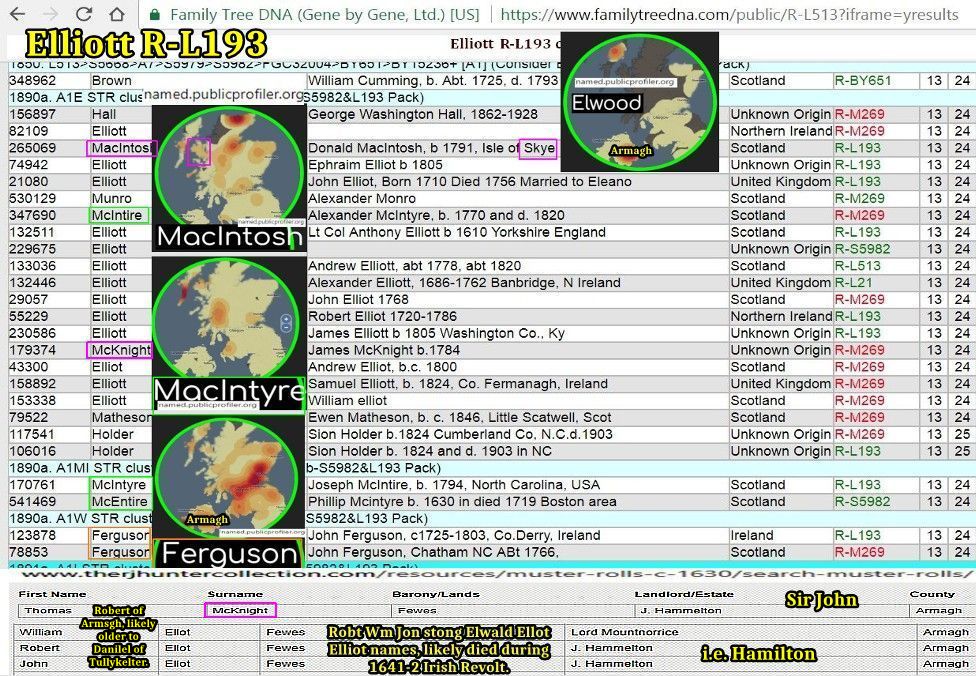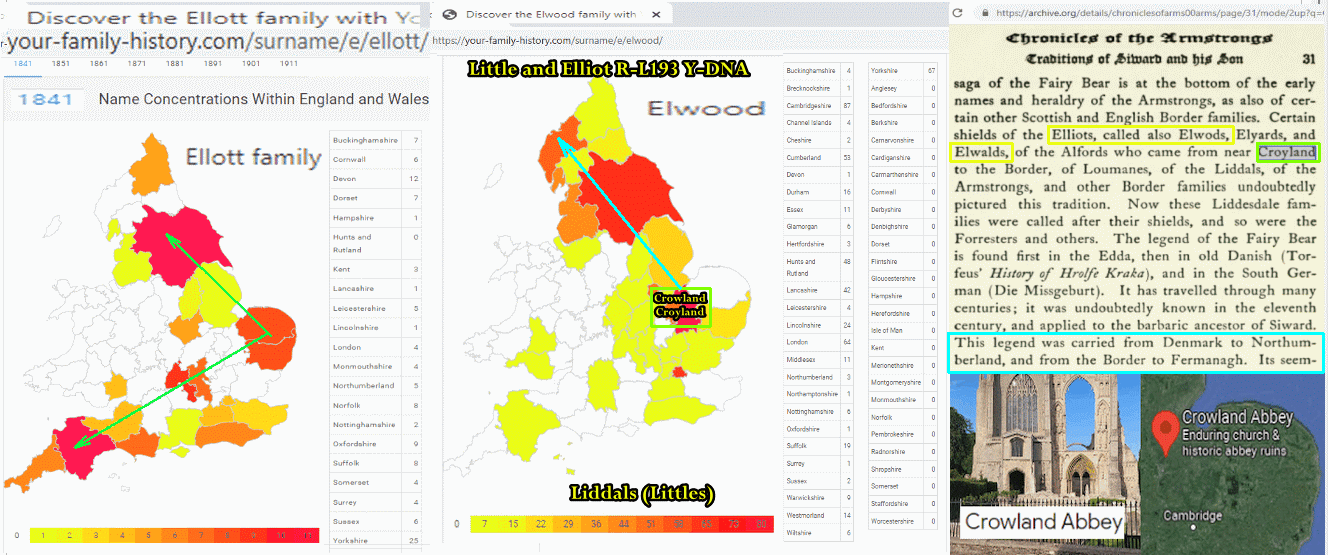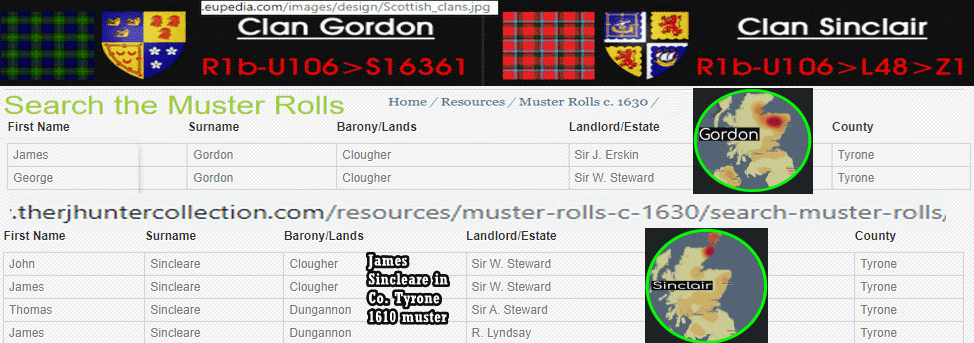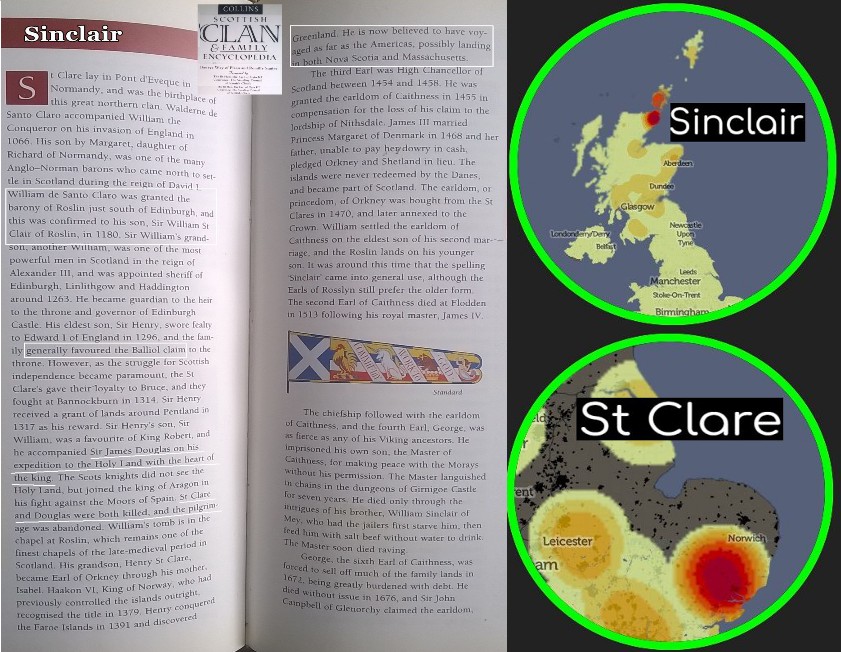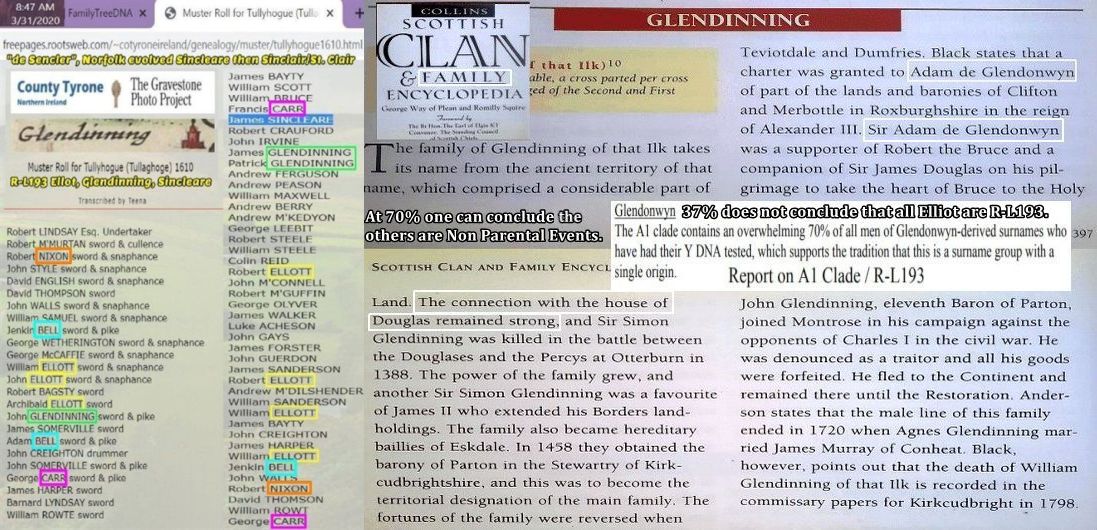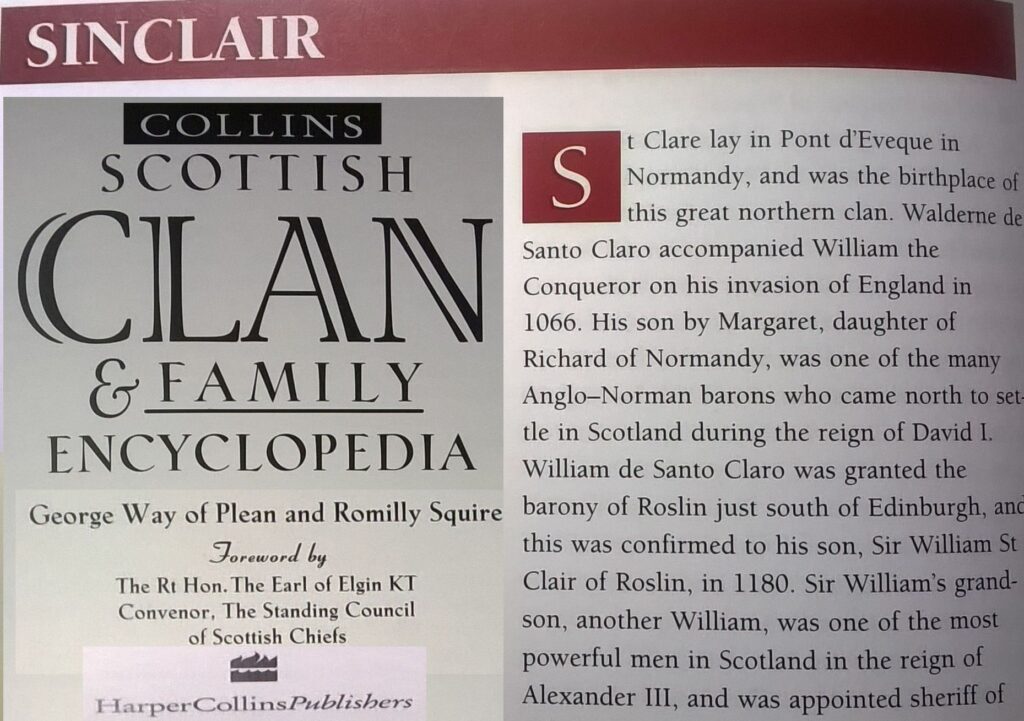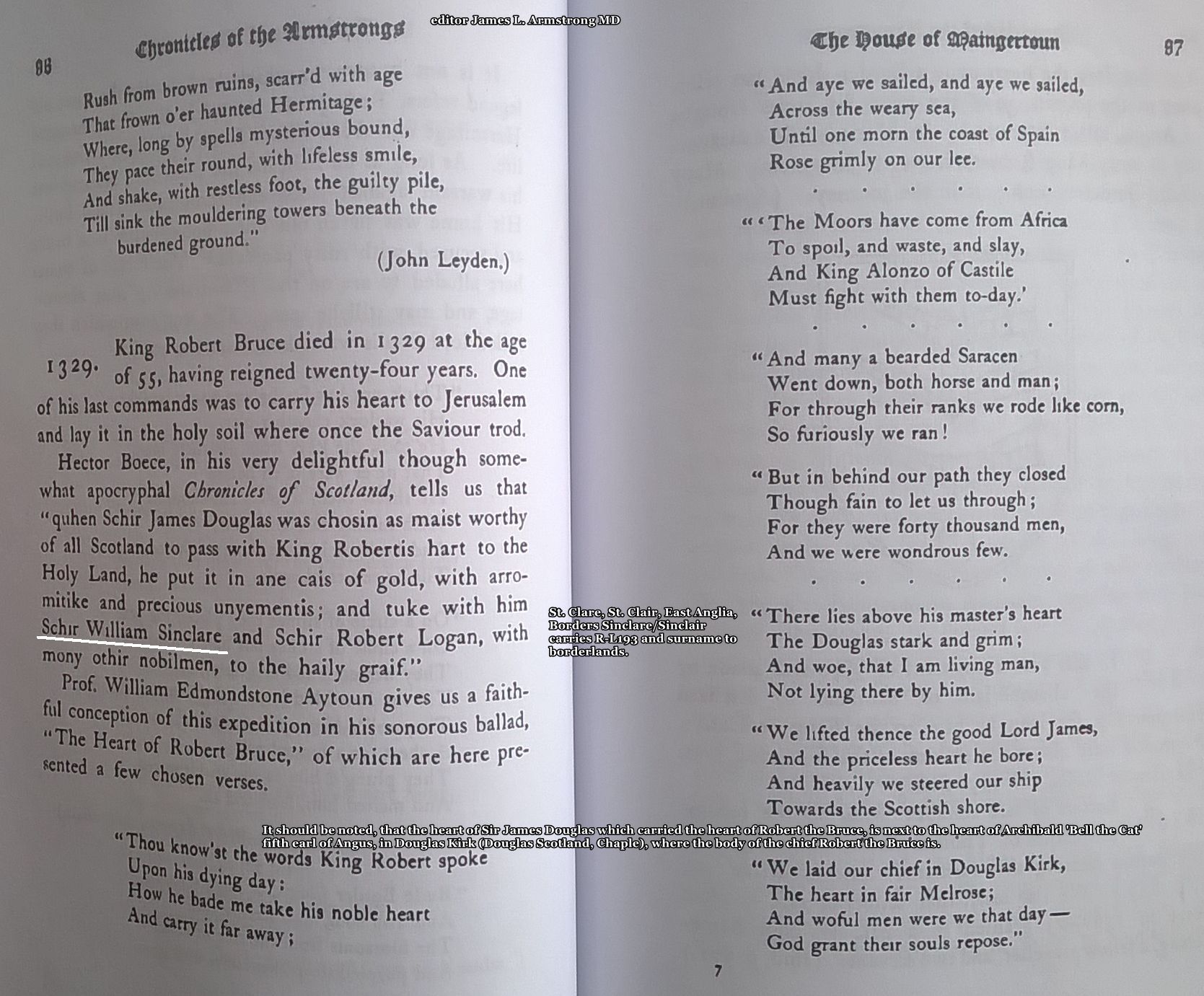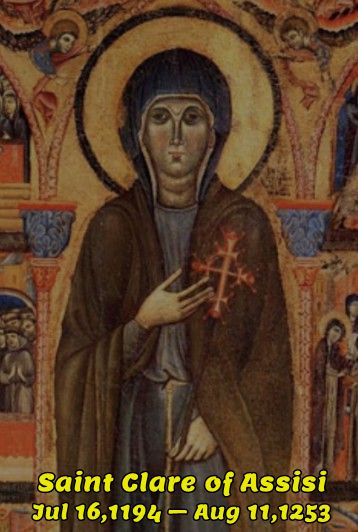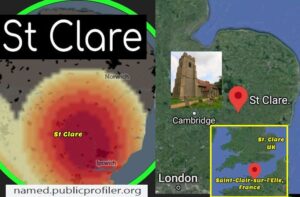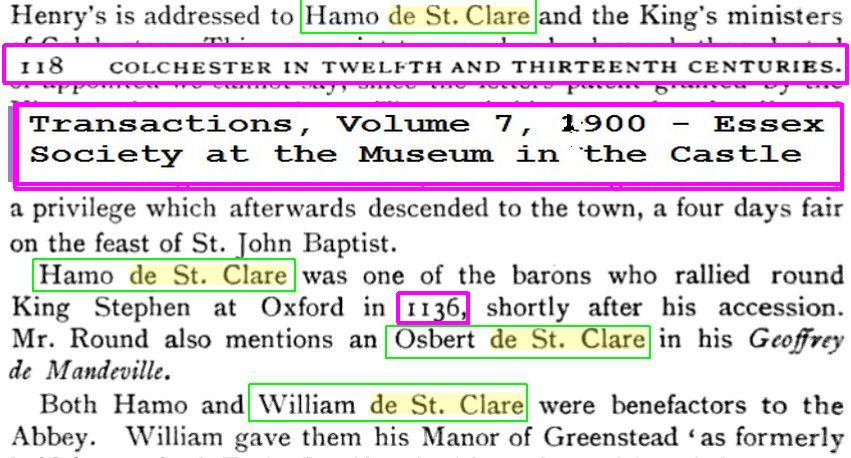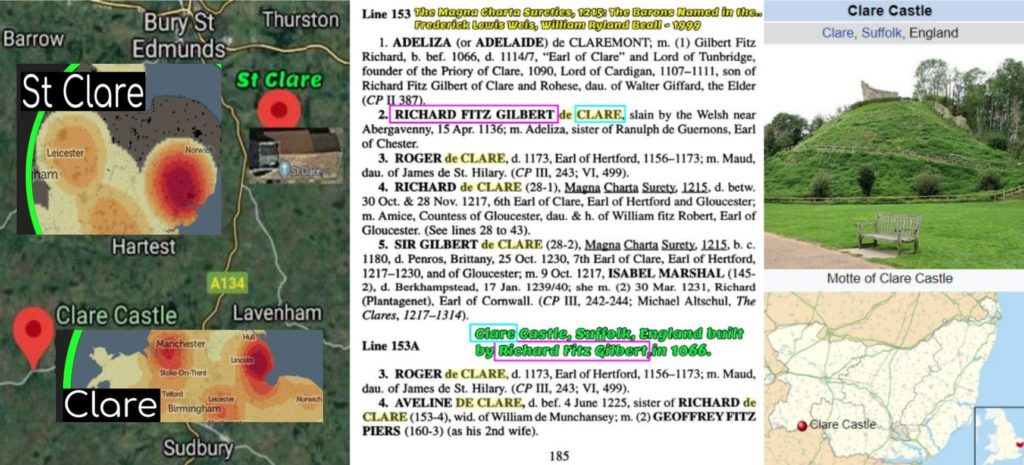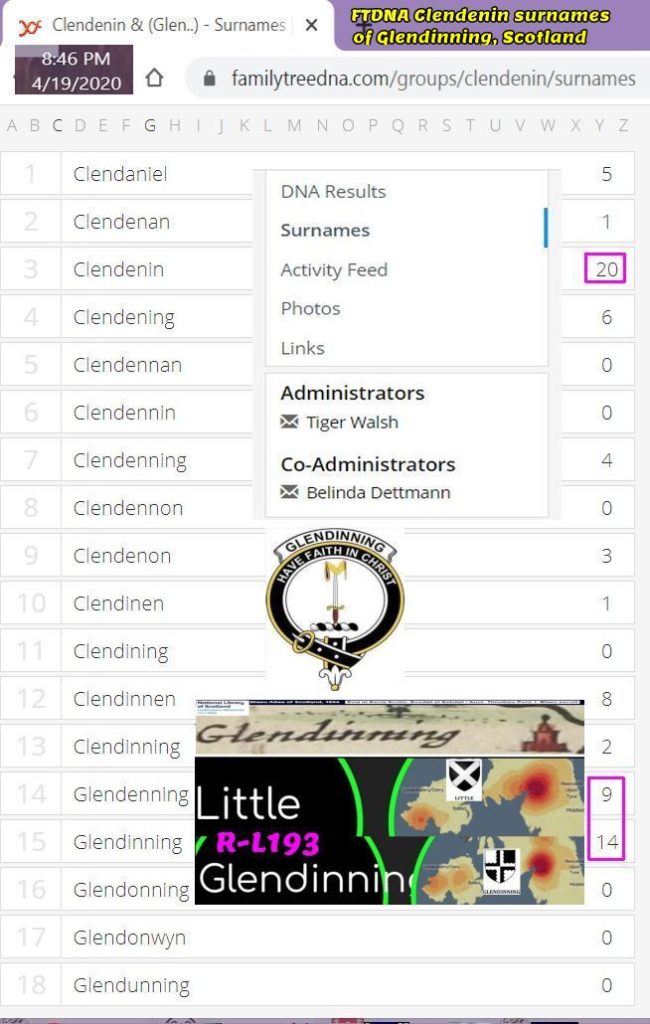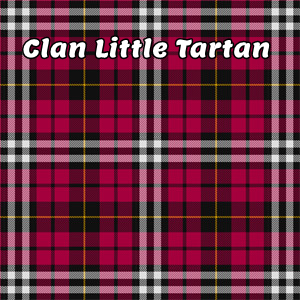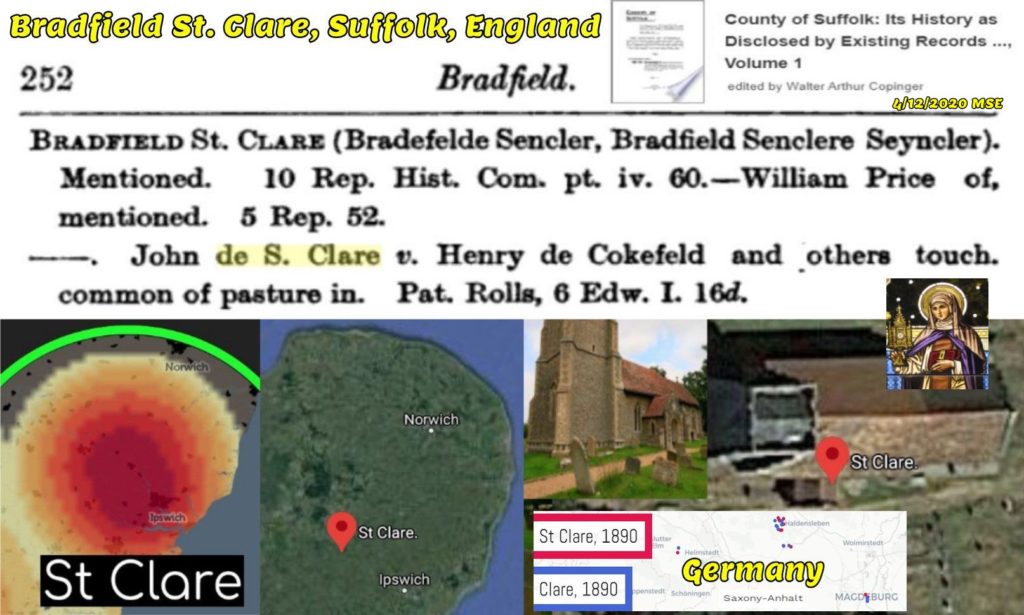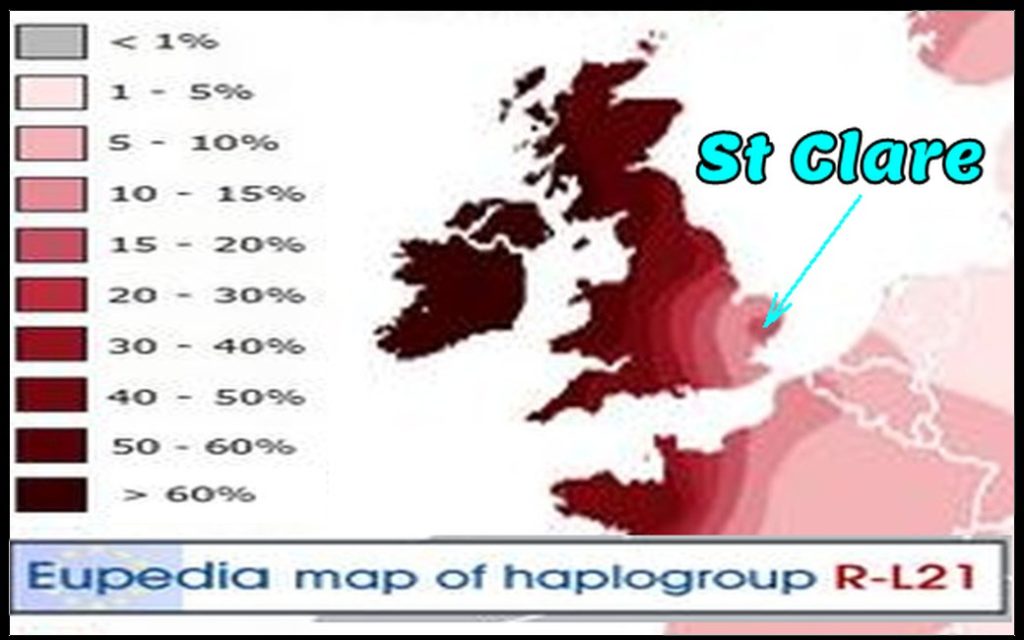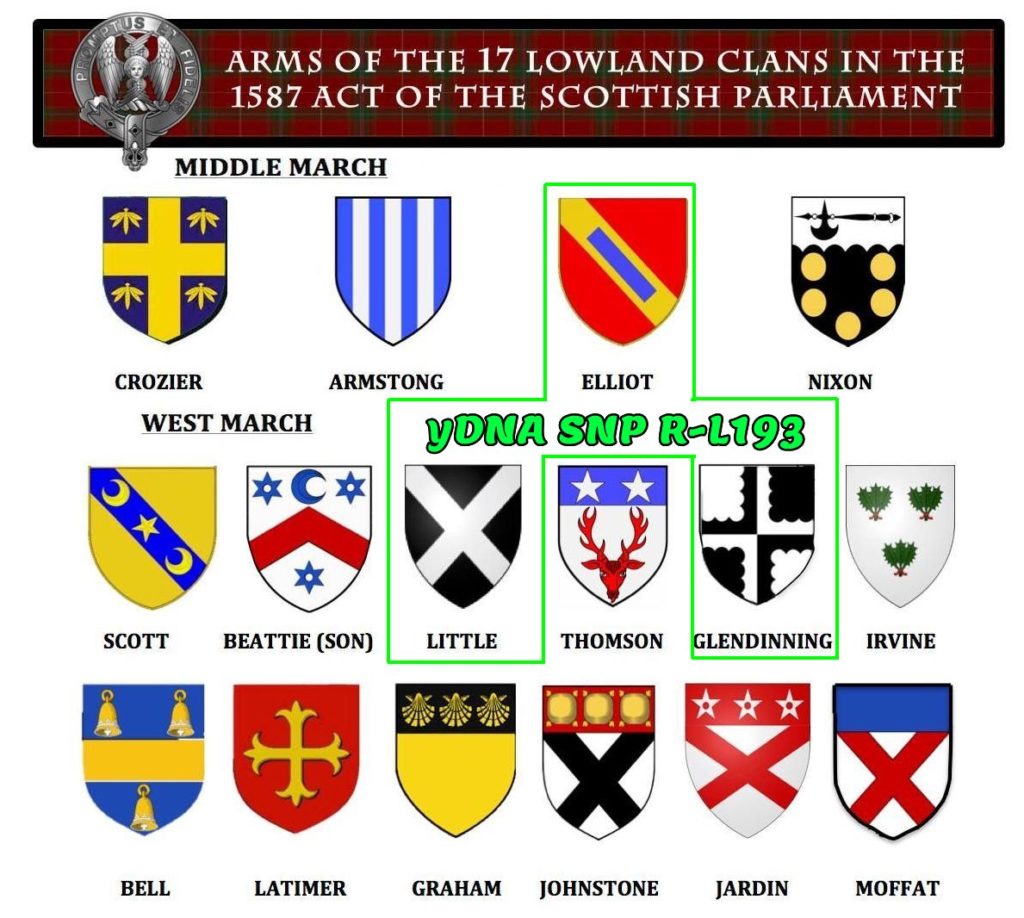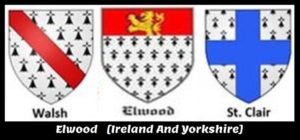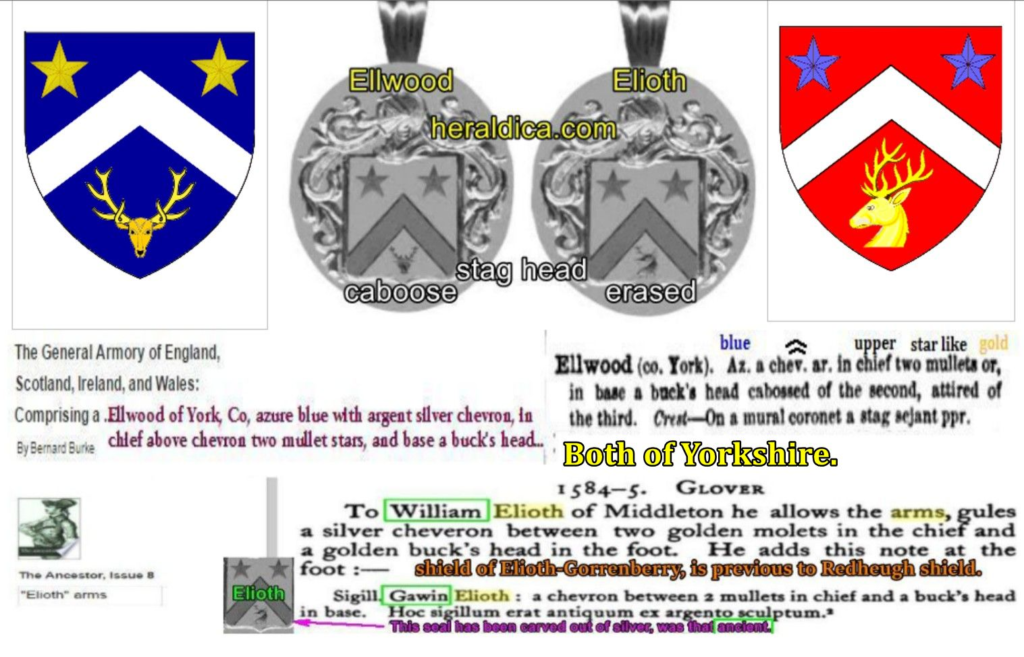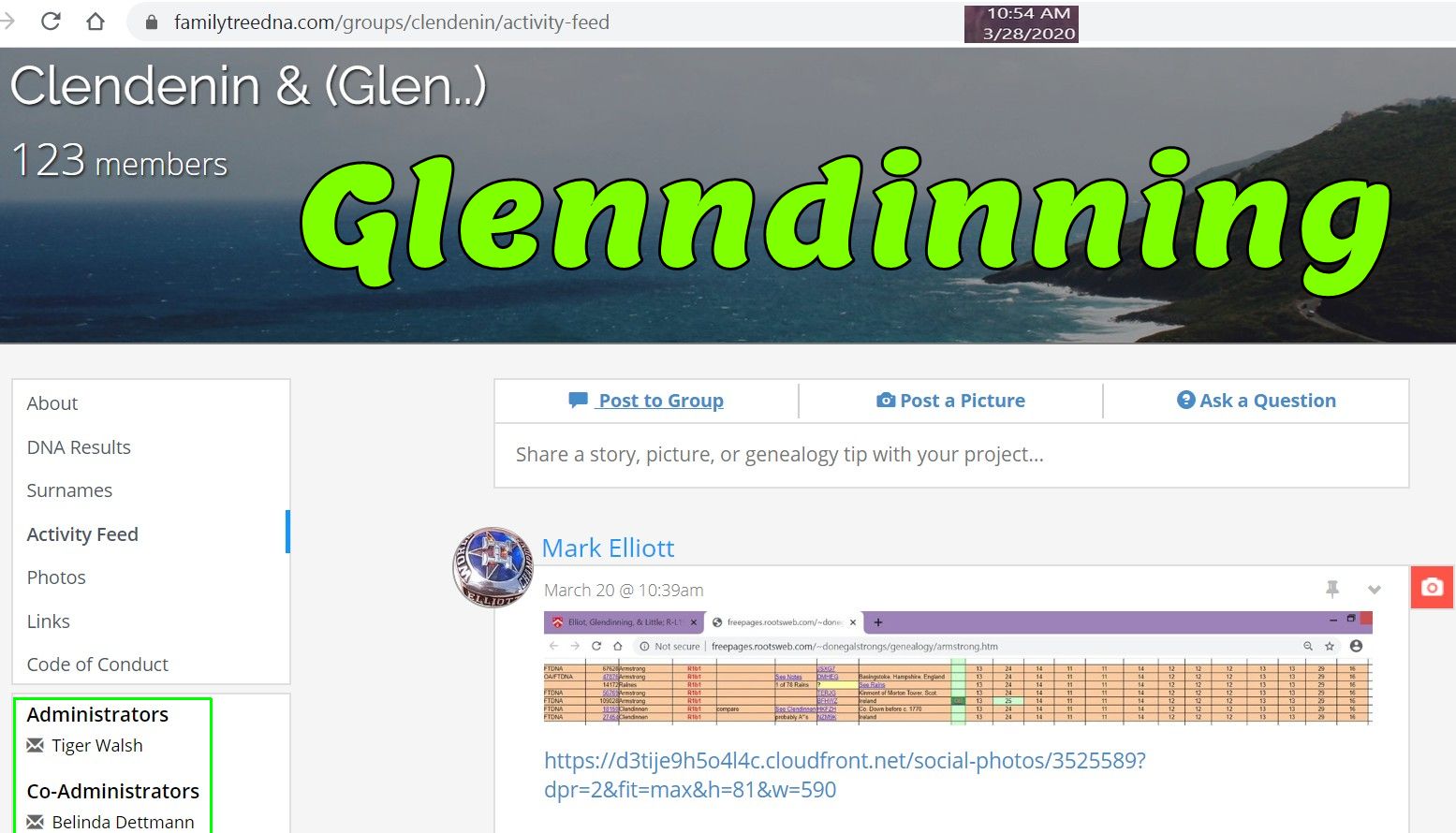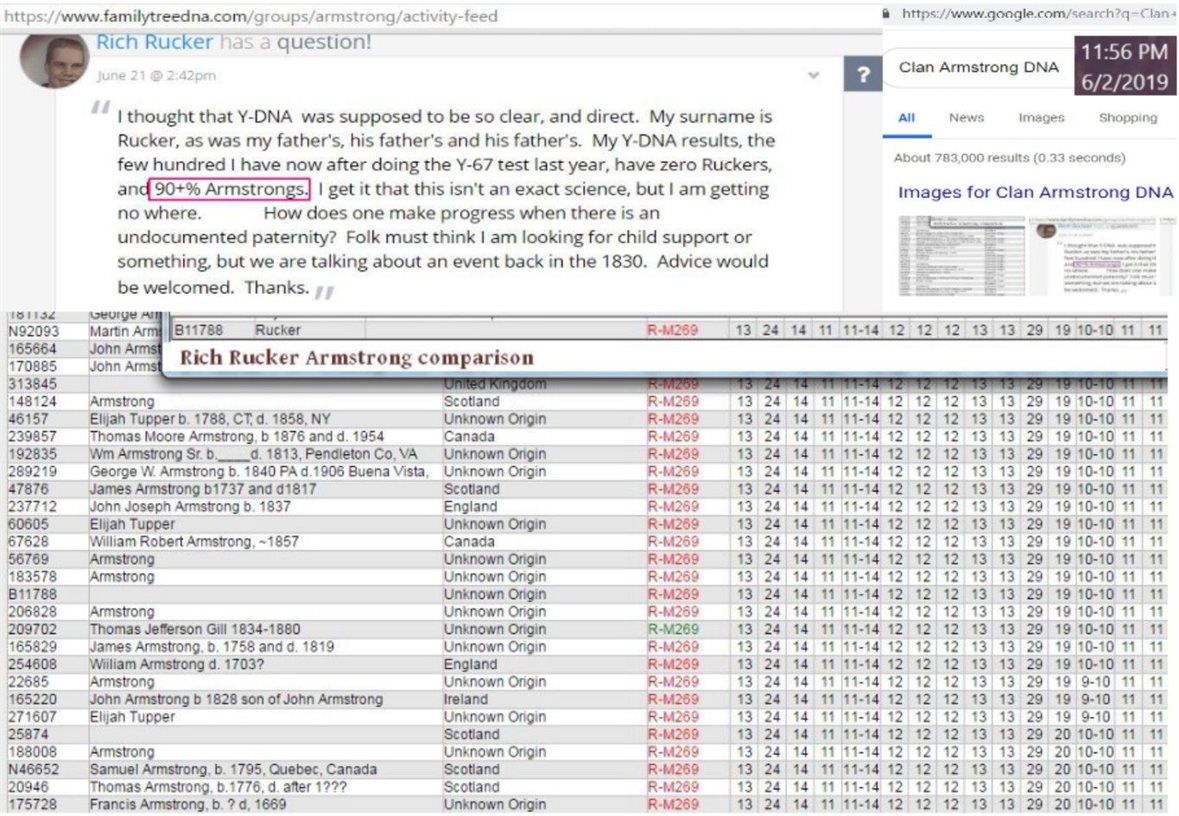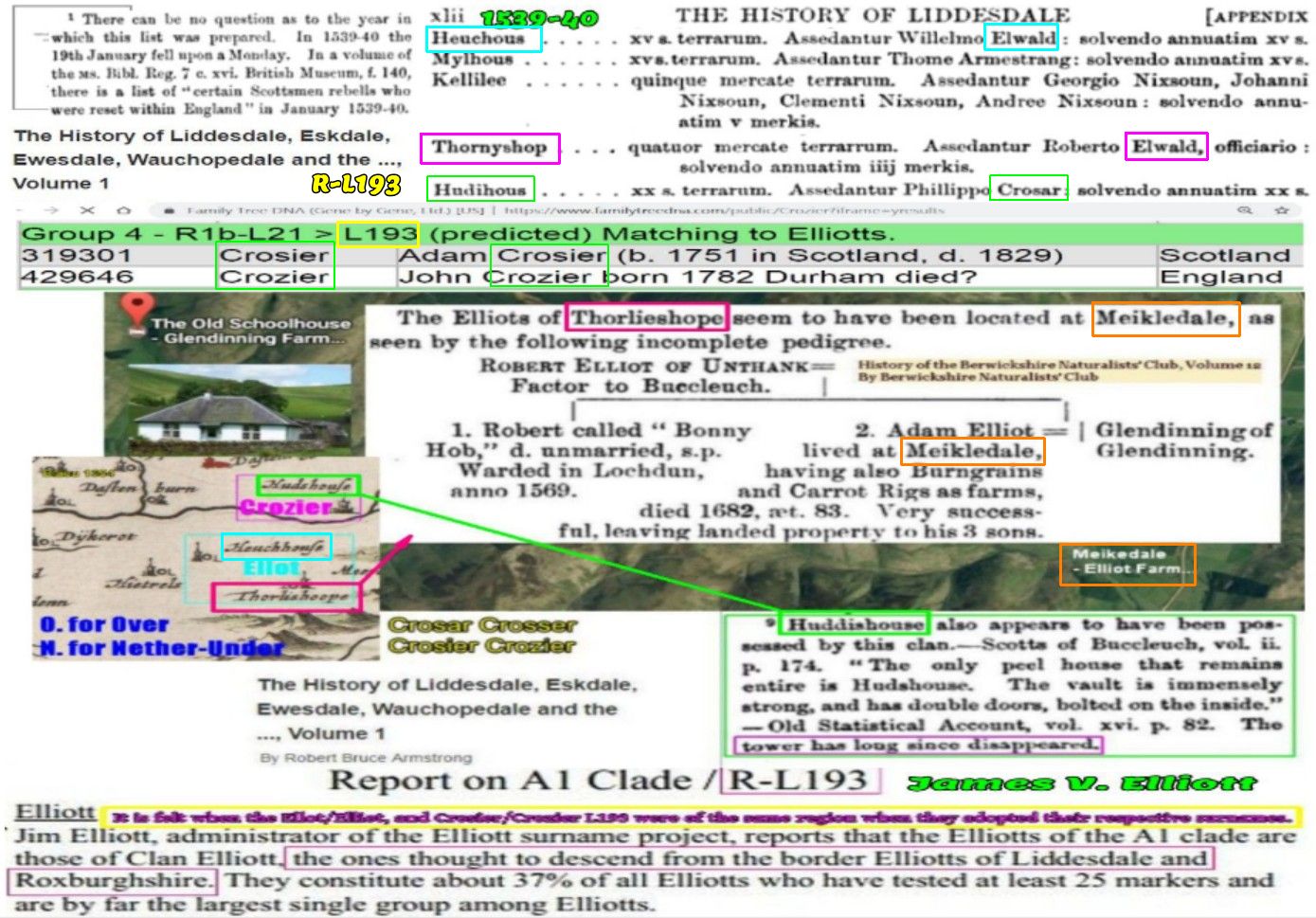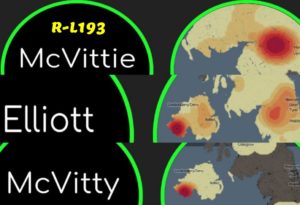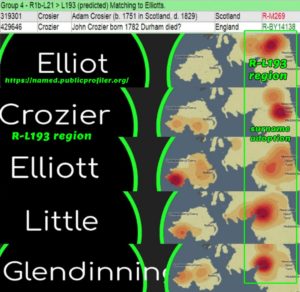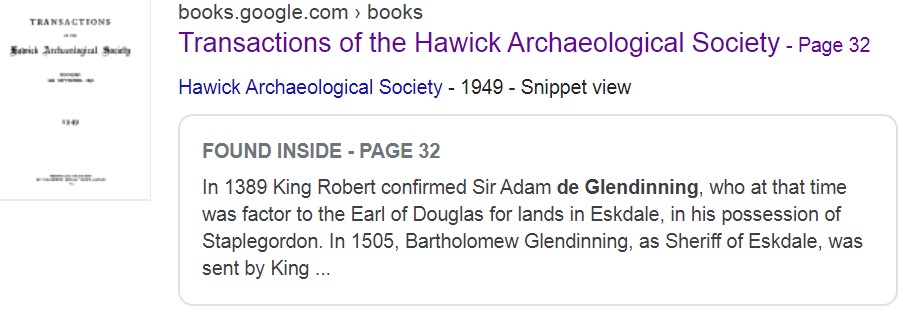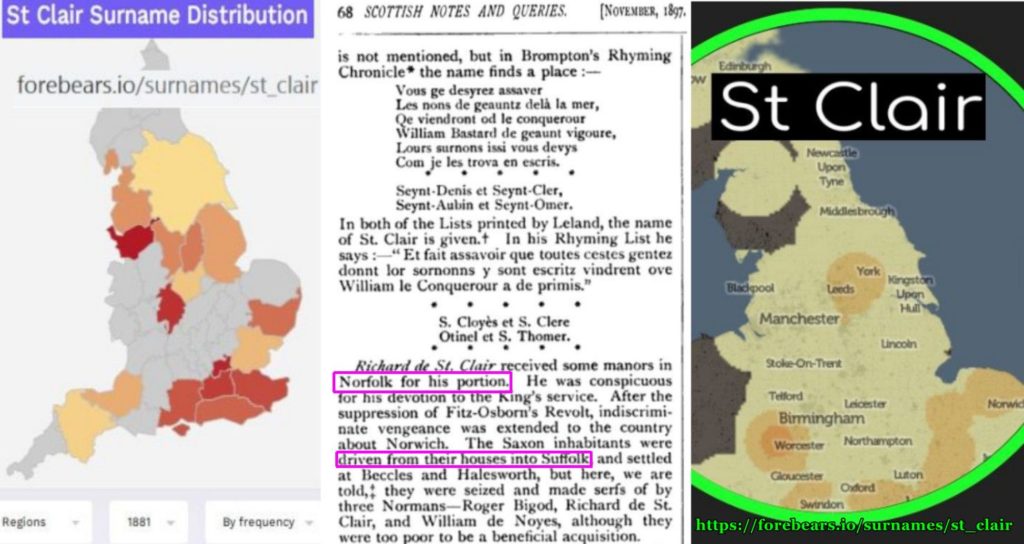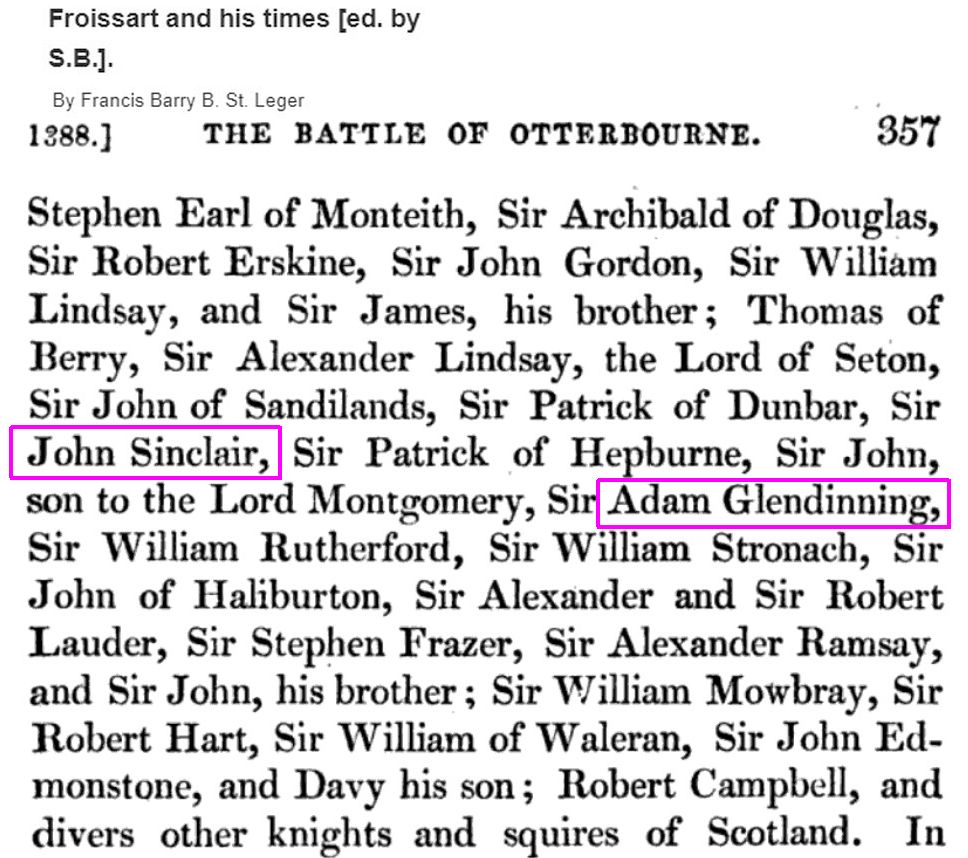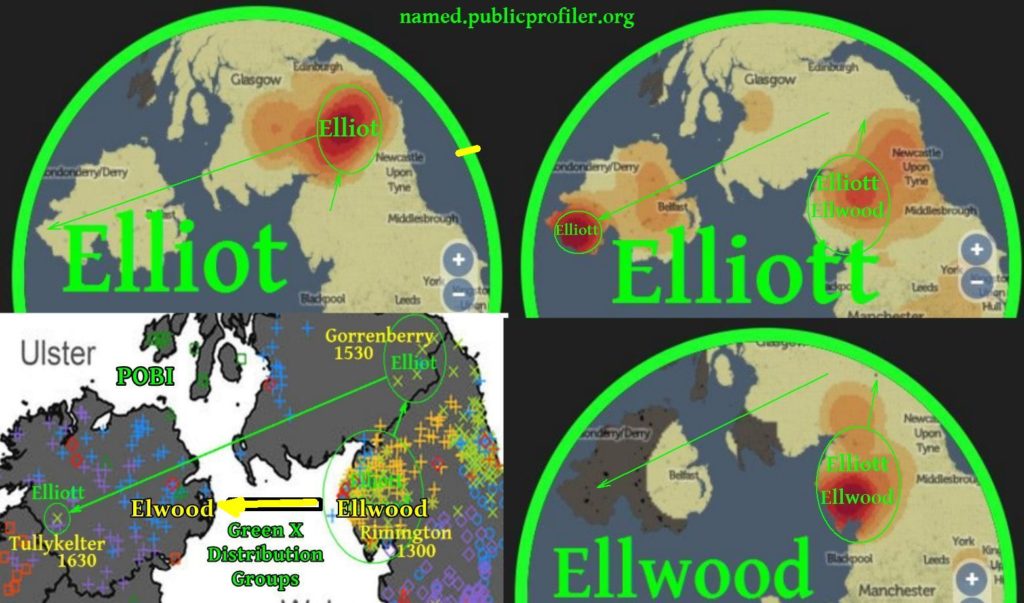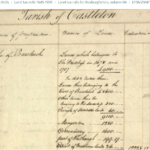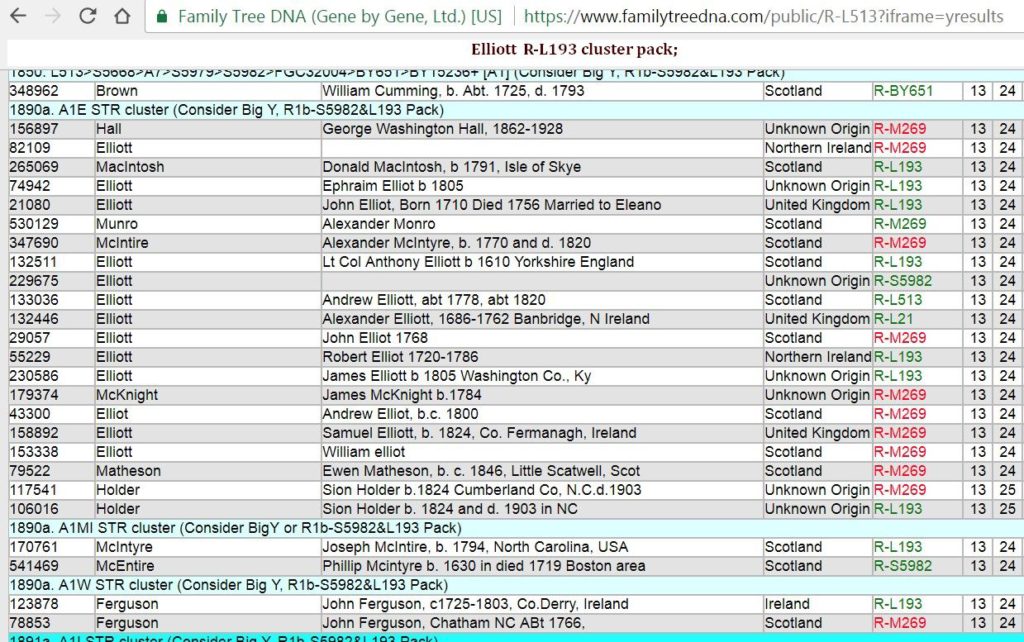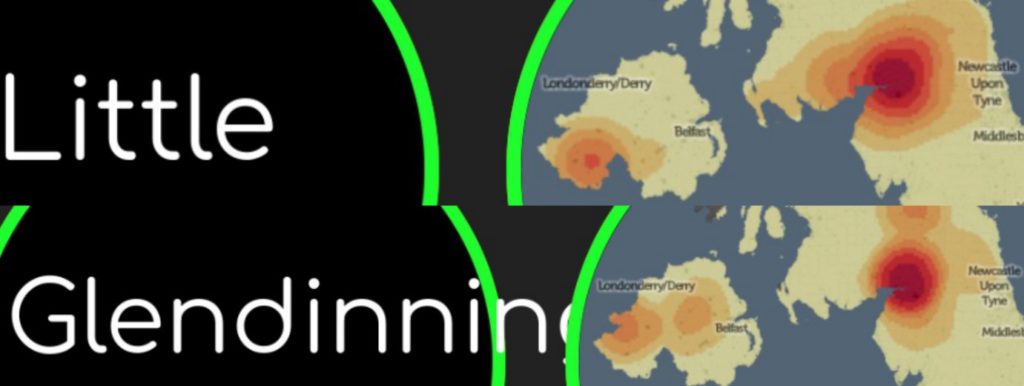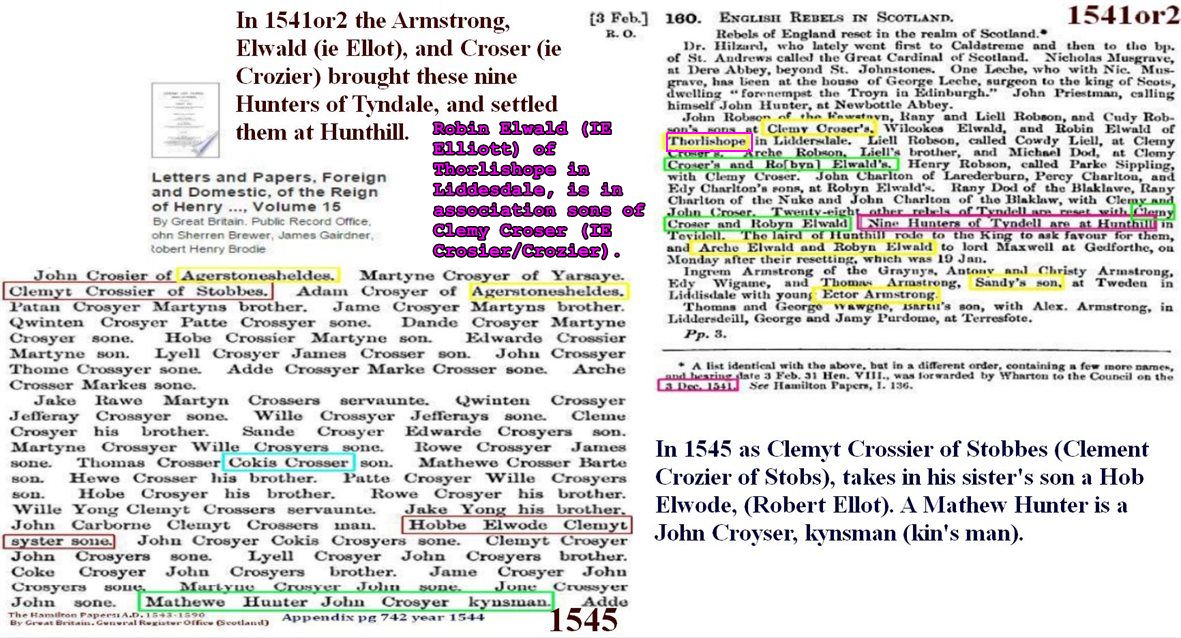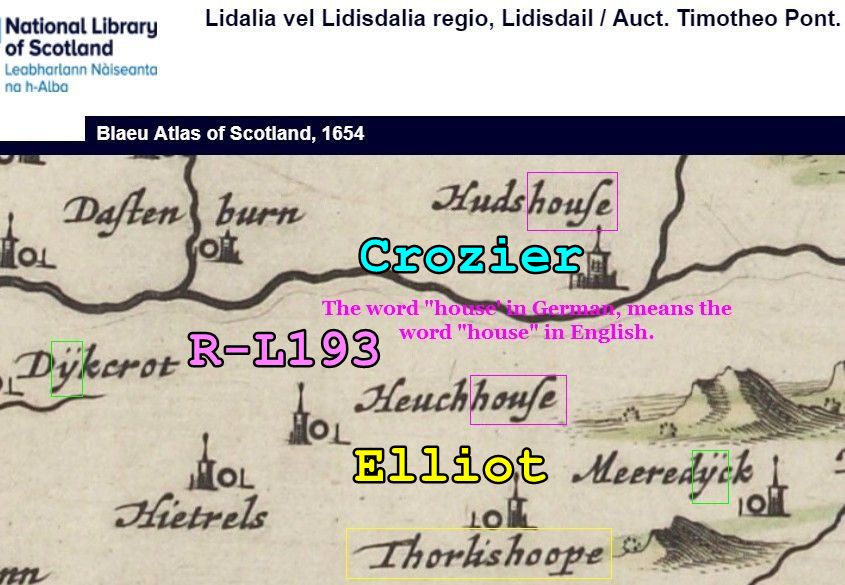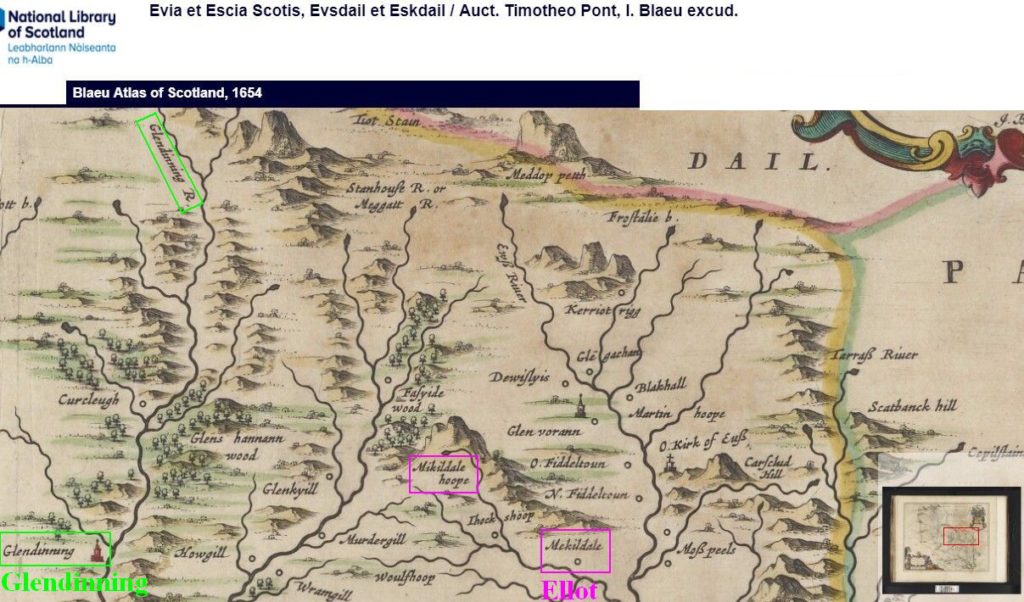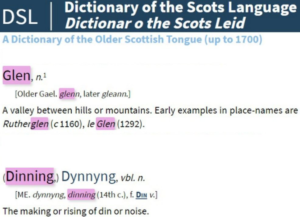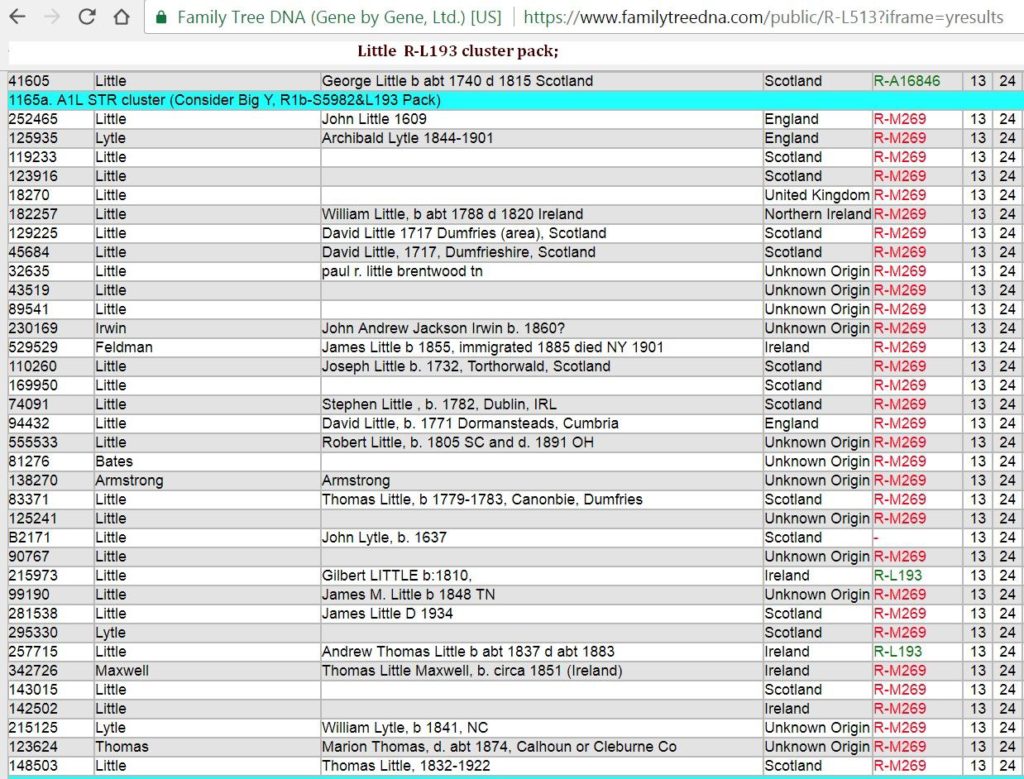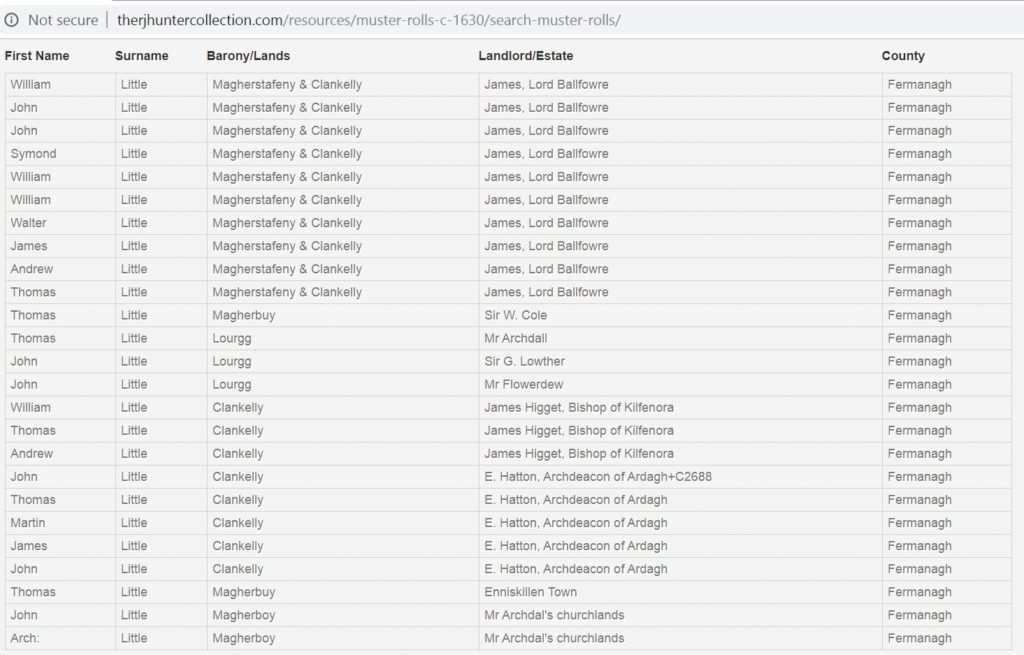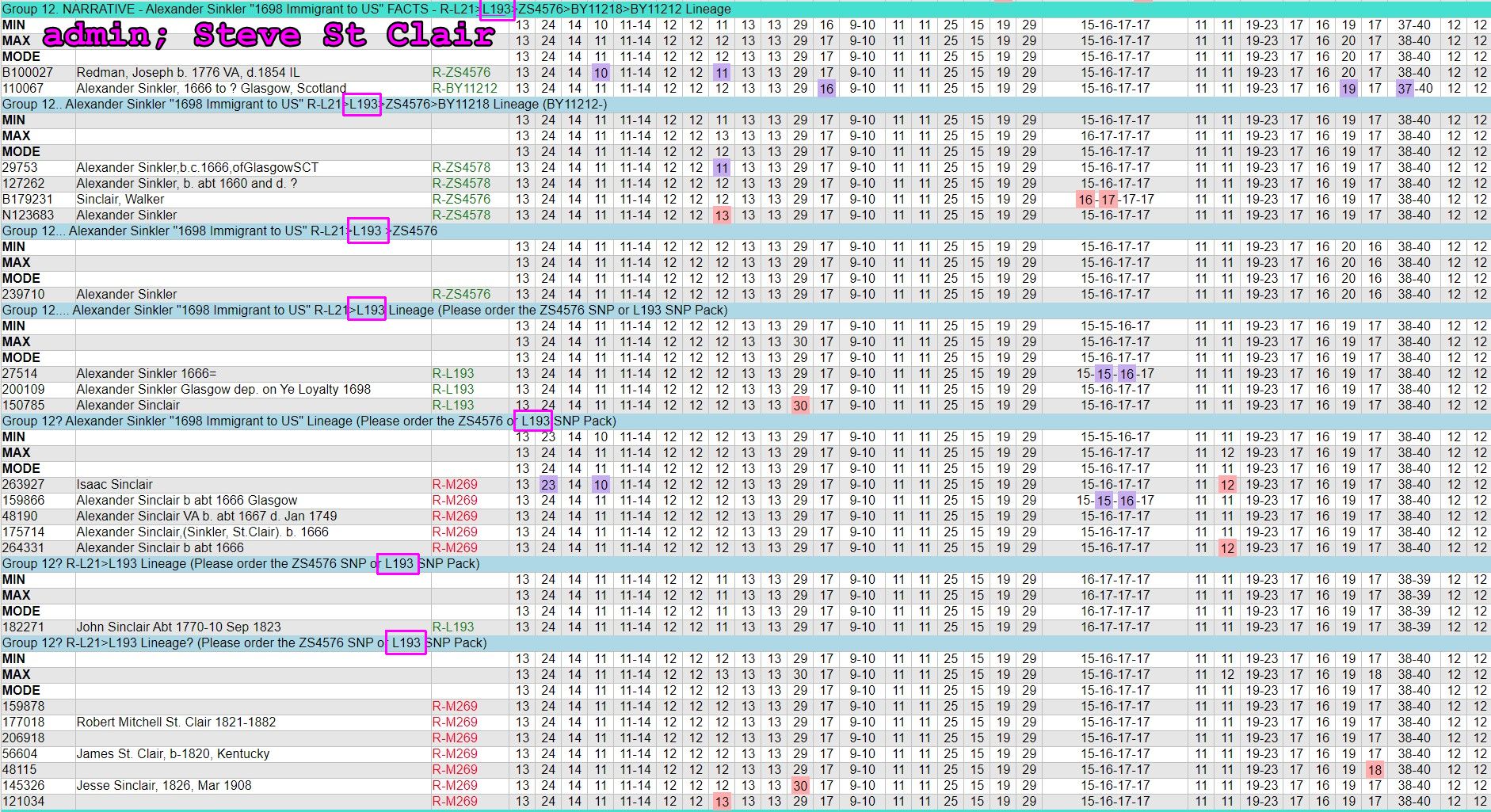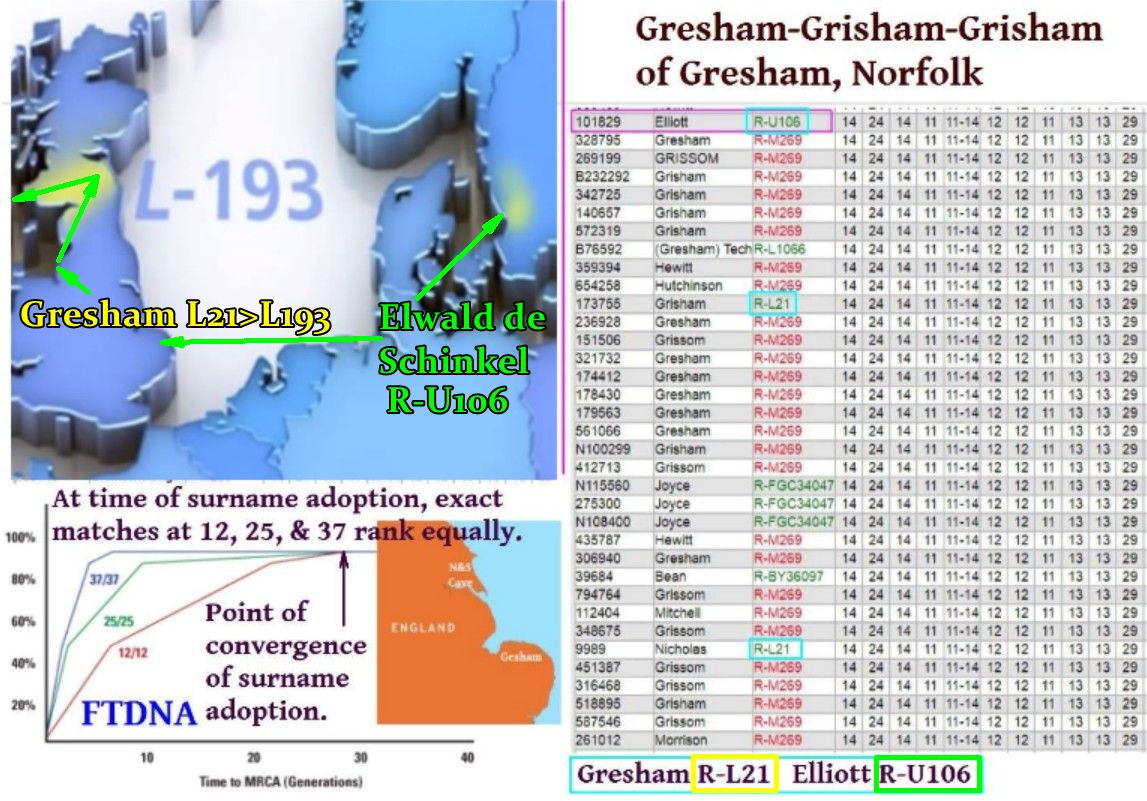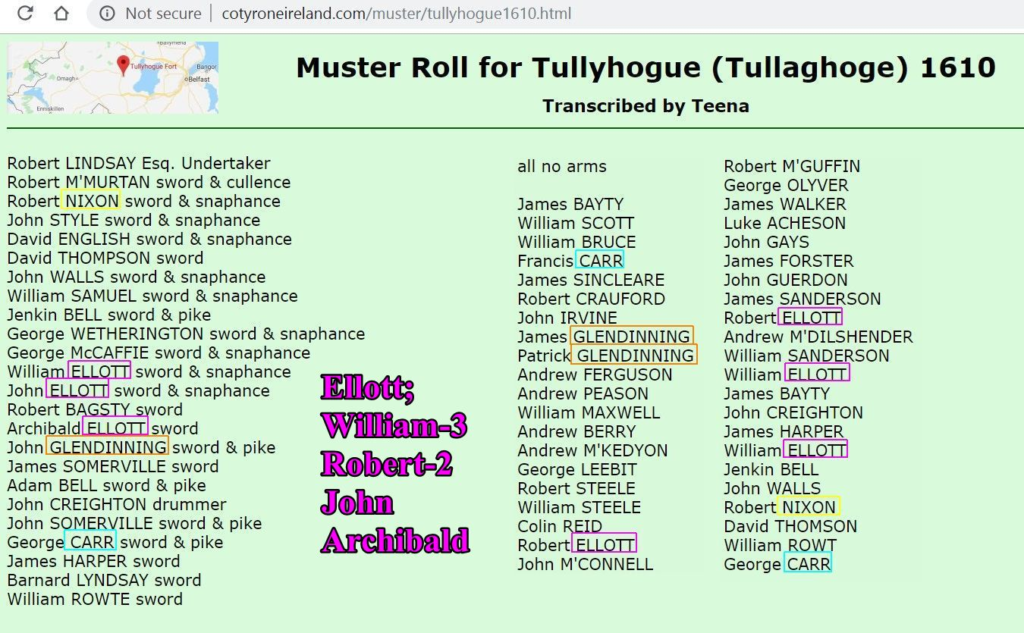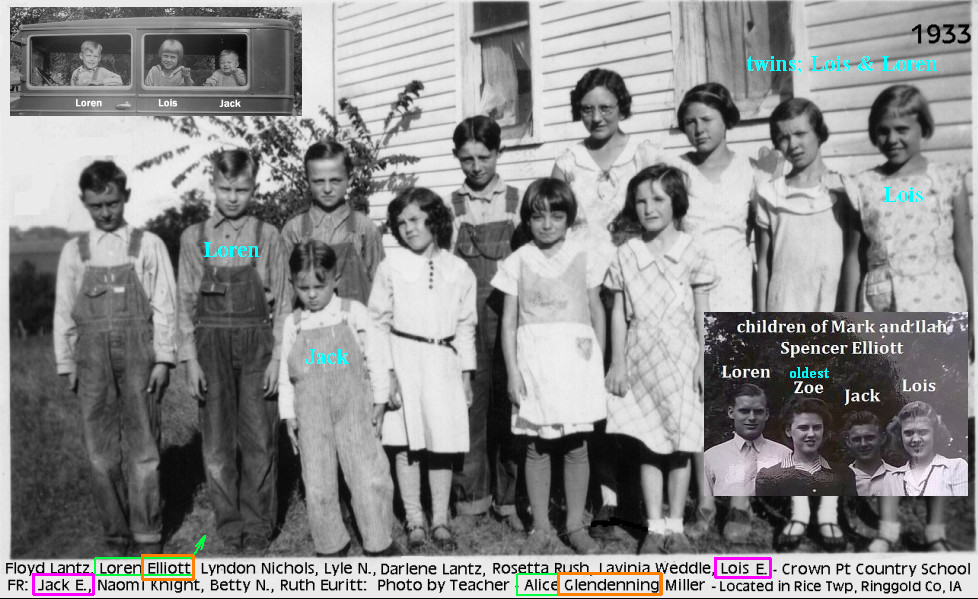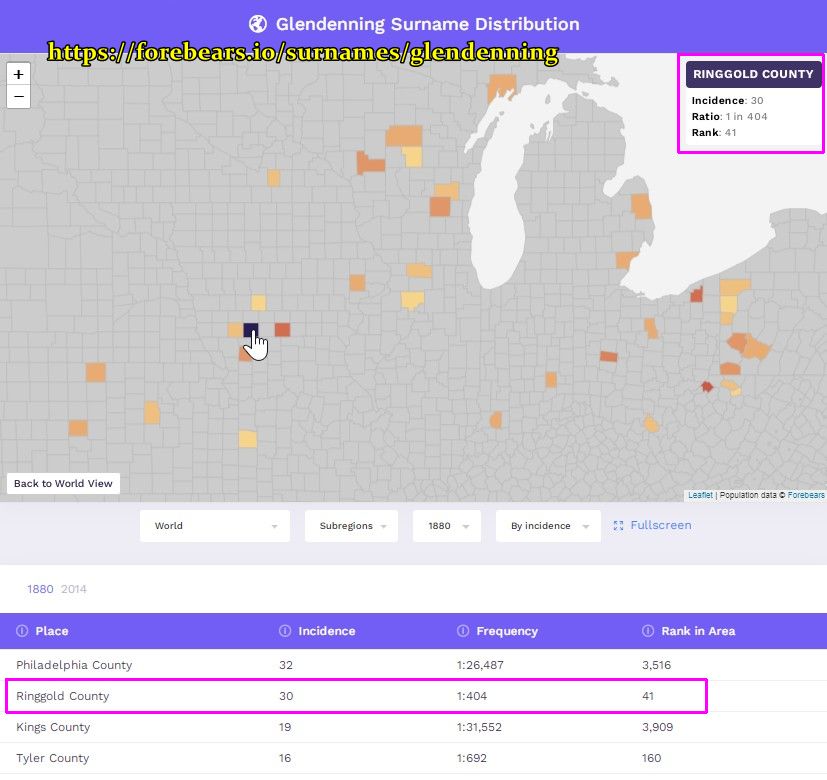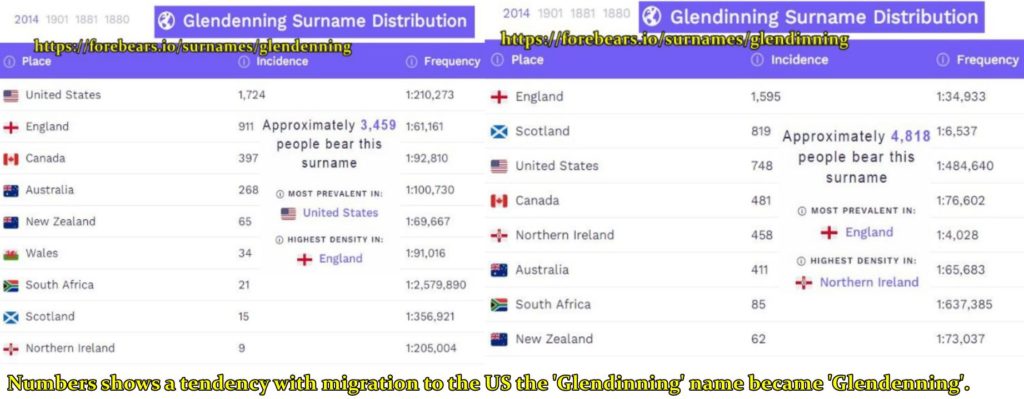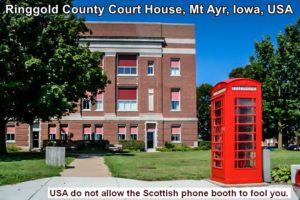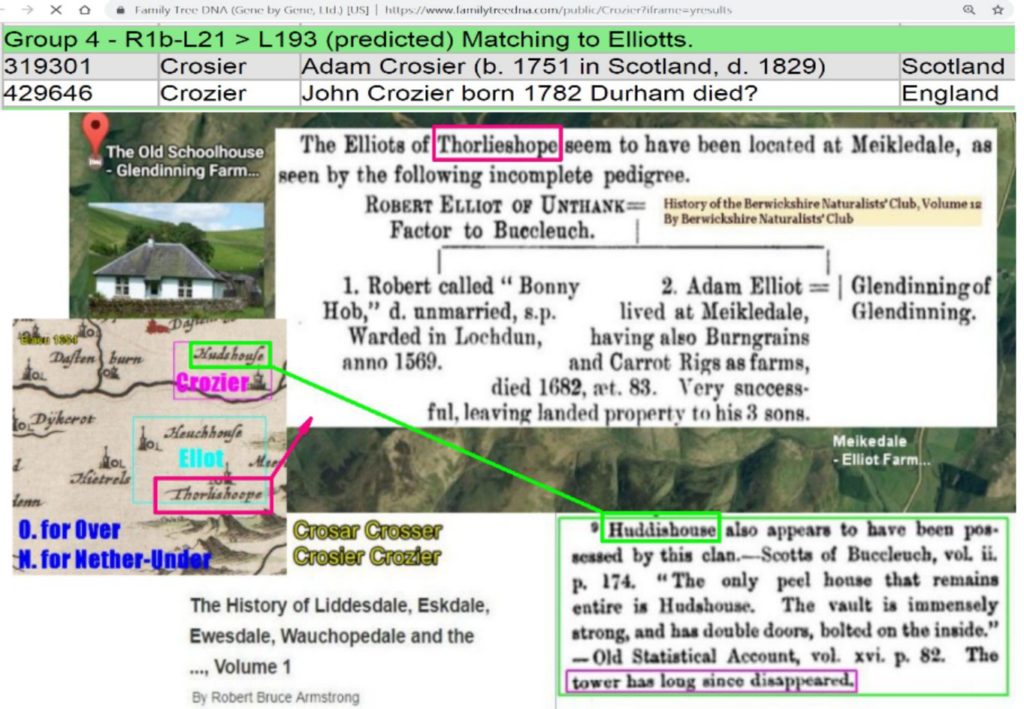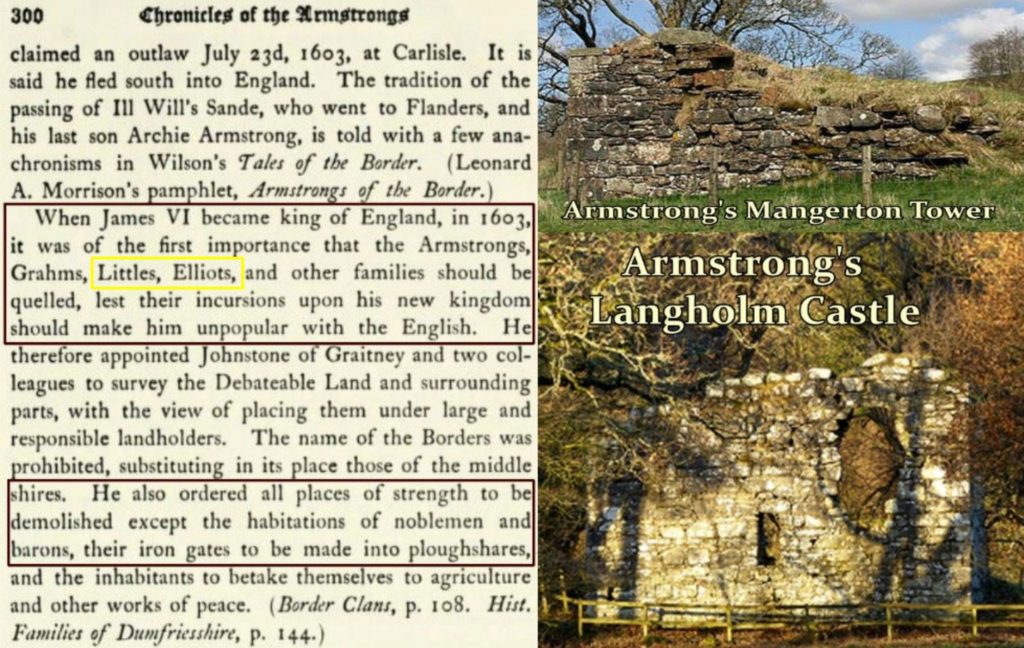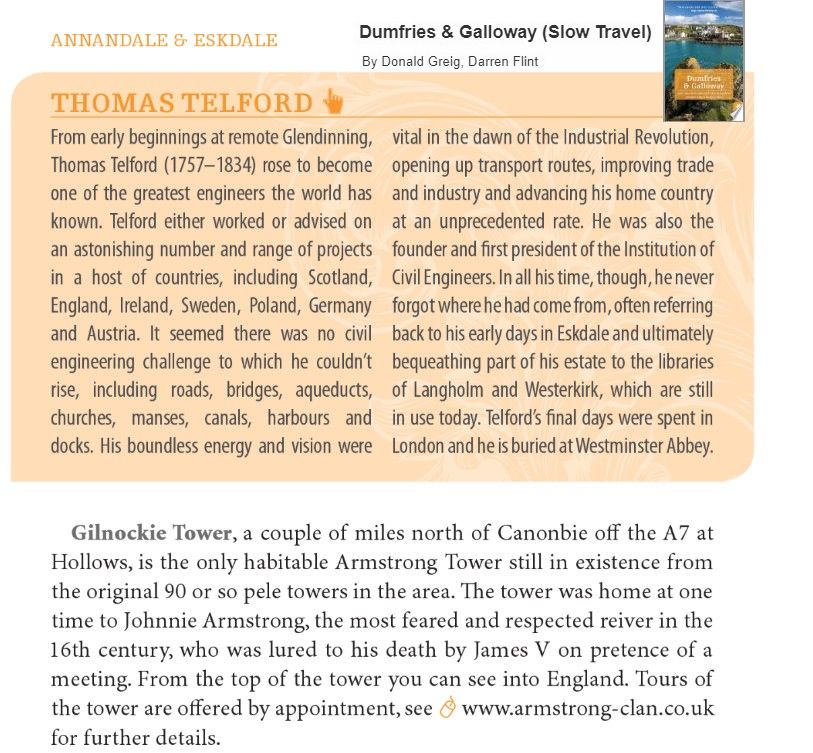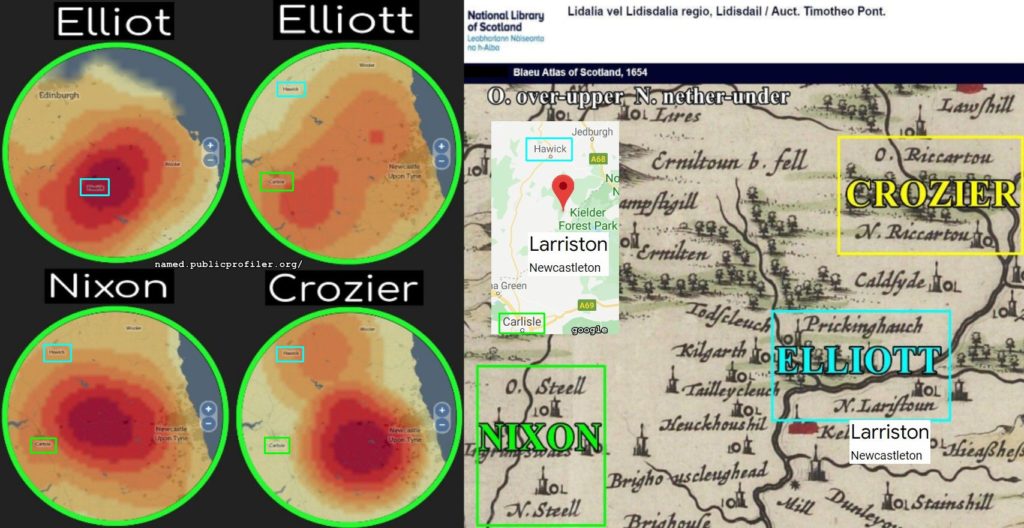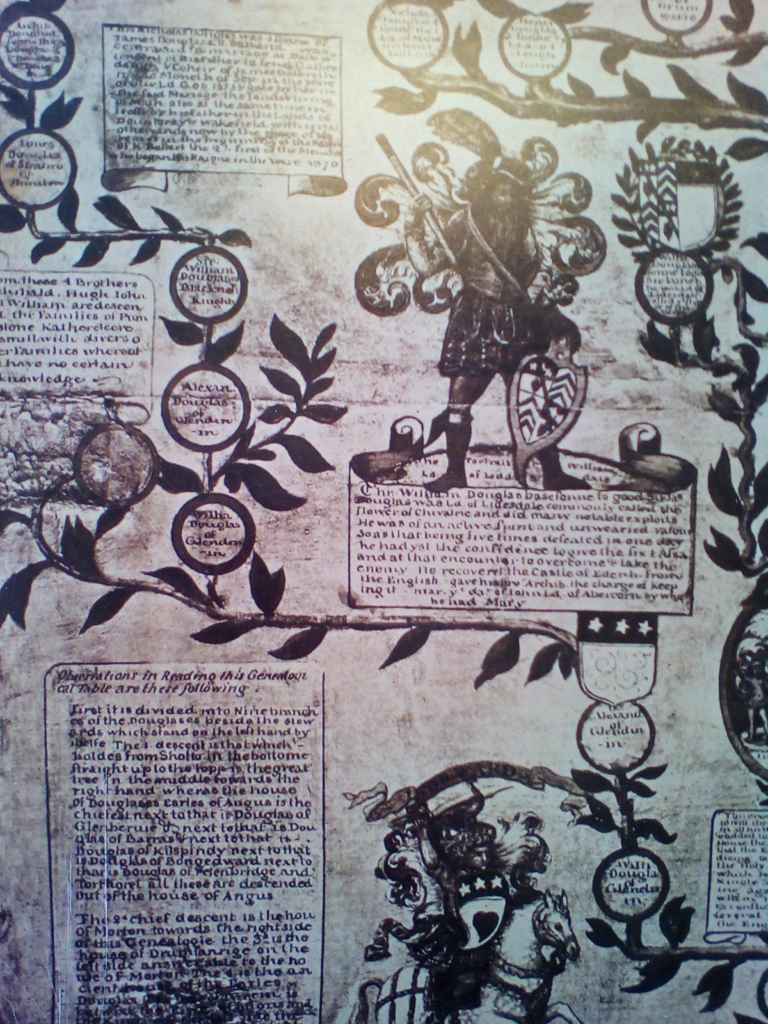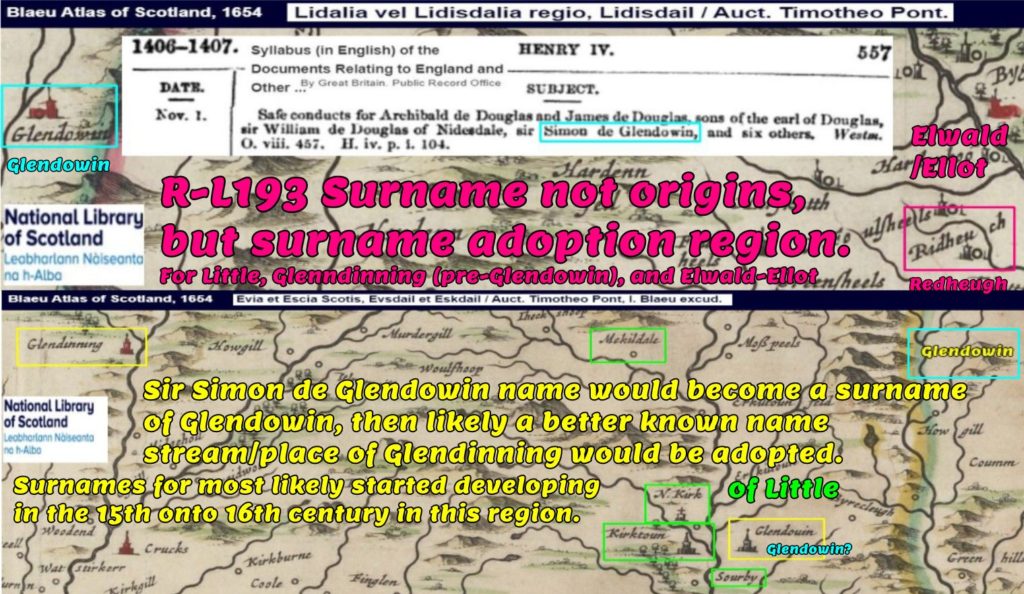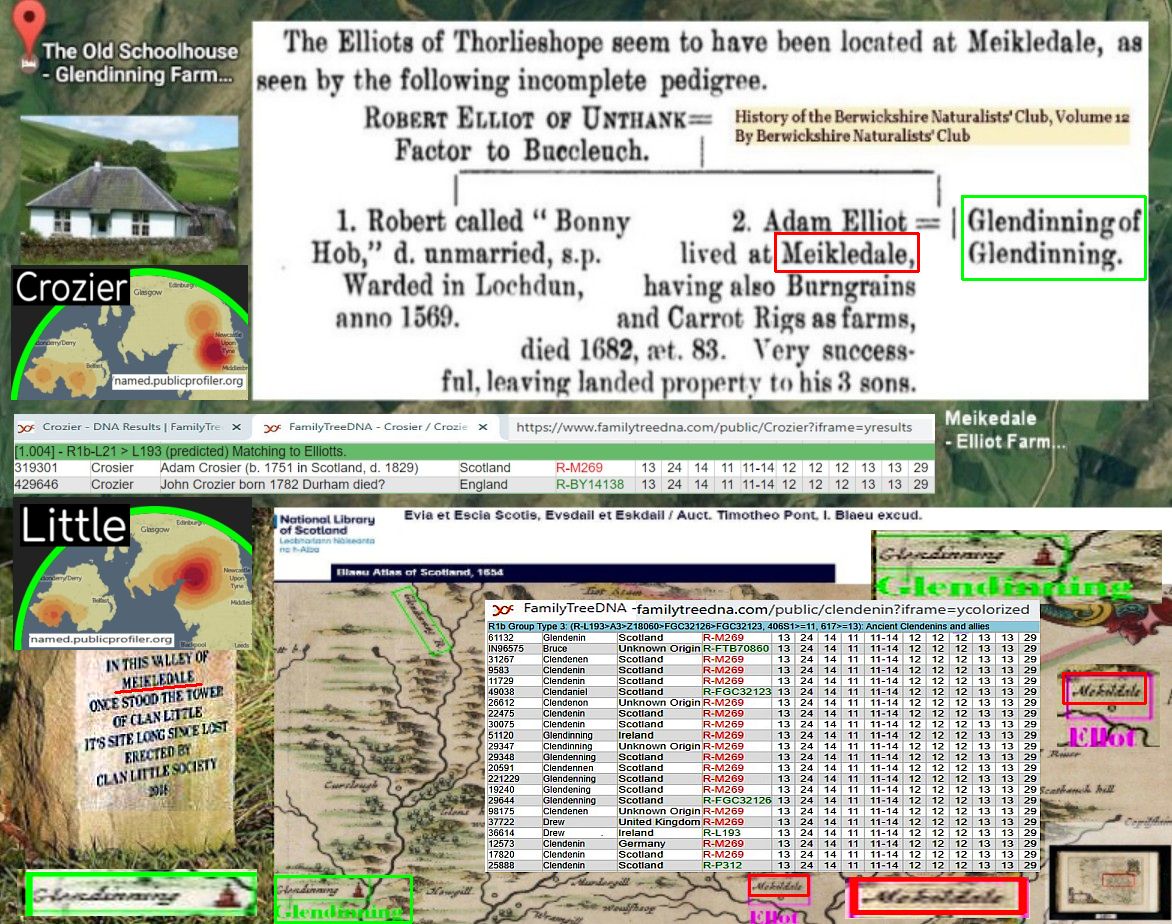 FTDNA Elliot Google Bing images 9/2022 – Gorrenberry
FTDNA Elliot Google Bing images 9/2022 – Gorrenberry
https://your-family-history.com/surname/e/elwood
https://archive.org/details/chroniclesofarms00arms/page/31/mode/2up?q=Croyland&view=theater
The Balliol Roll, the earliest roll of arms for Scotland. It contains thirty-five shields of Scottish noblemen arranged beneath the arms of Sir Edward Balliol, king of Scots (c. 1282-1364), and was almost certainly composed for that ruler. Edward Balliol, the last of the Anglo-Scots, was the son of John de Balliol (King John of Scotland) and Isabella de Warenne, daughter of John de Warenne, 7th Earl of Surrey.
http://www.douglashistory.co.uk/history/heraldry/balliol_roll.html#.YN4h2OhKjIU
click right to enlarge image in new tab
https://named.publicprofiler.org/
St Clare became an early surname of landholders, migrated to the borderlands, they spread their R-L193 Y-DNA among Elliot, Glendenning, and Little, in the borderlands around Glendinninng, Scotland. “MONTACUTE PRIORY Montacute Priory was a Cluniac priory of the Benedictine order in Montacute, Somerset, England, founded between 1078 and 1102 by William, Count of Mortain. It was the only Somerset dependency of Cluny Abbey until 1407. Bretel St Clare was a witness to the foundation charter of the priory of Montacute by William, Earl of Moreton, son of Earl Robert.” http://www.stclairresearch.com/content/groupingsVa-R-L193-DNA.html Name St Clare evolved to St Clair/Sinclare then north Scotland to Sinclair. Border surnames were adopted years after surnames of land holders have been adopted. the Y-DNA was brought to the borderlands at the time of border surname adoption. “William de Stanto Claro (St Clare) was granted the barony of Roslind just south of Edinburg …. William St Clair of Roslin, in 1180.” Way before most border people had adopted surnames beginning in about 1400.
It is felt that the St Clare name with R-L193 as landholders was brought into the Scottish-English Borderlands, where surnames where not of use, and people adopting surnames from Glendinning of Glendinning Flu drainage in Scotland and to the east of the Glendinning, the Little (of Liddel Water), and the name Elliot, of region were surnames adopted of men having R-L193. Lets say dropped off by the migrating English St Clare, becoming the more numerous Sinclair landholders to the north in Aberdeenshire. The names Glendinning, Little, and Elliot, during the ‘Pacification’ exile and extermination of border families during reign of James VI of Scotland becoming James I of England, many of these surnames still today are found in the Ulster Plantation of North Ireland.
Image: Saint Clare | original painting for the Poor Clares in Cincinnati, OH
Saint Clare of Assisi Saint of the Day for August 11 (July 16, 1194 – August 11, 1253)
Last name: St Clair (de St Cleare / Sincleare)
Read more: https://www.surnamedb.com/Surname/St%20Clair#ixzz6IHZYAilM
http://www.stclairresearch.com/content/groupingsVa-R-L193-DNA.html
“Castle Acre, Norfolk, England – In 1085, Ricardo de Sancto Claro
was a witness to charter of the powerful William de Warenne
(a near-kinsman of the Conqueror) to the priory of Castle Acre.”
Felt that the R-L193 was brought up into the Border Region by the Sinclare/St Clare. At time which the Sinclare/Sinclair name was introduced to region, the families of people who became Little, Glendinning, and Elliot R-L193. The families of aristocrats, seem Gordon, Irvine, Hamilton, Sinclair, Brus seem to have been discouraged away from the Borderlands, into Aberdeen, Caithness, and surname seeding towards the Orkneys.
Last name: St Clair (de St Cleare / Sincleare)
Saint Clement, and earlier Saint then Saint Clair/Clare, found clear water for prisoners where a lamb once stood. The name Sincleare, Saint Cleare, and St Clear are utilized. Clement is a name which is carried over to the borderlands, and it is felt that this Sincleare, of Saint Clement, otherwise may have been known as Saint Cleare, may have derived the name Sinclare/Sinclair.
SDB Popularity ranking: 2222
Read more: https://www.surnamedb.com/Surname/St%20Clair#ixzz6IHZYAilM
The Sinclairs of England
Trübner, 1887 – Great Britain – 414 pages
Late seventeenth century Sincleare of Maryland.
Norfolk Record Society – Volume 8
Sheppard, Edm., 59. Sherlow, see Sharlowe. Sherman, see Shearman. Sherwood, Tutill, 49. Shipman, W., 11*. Shipp, Rbt., 67. Shiryng, Rbt., 9. Short, J., 5o. Shotten, T., 63. Simpson, J., 67. Sincleare, Sencler, Pk., 65; T., 8*. Skales, Rbt
https://www.familytreedna.com/groups/northumberland-england/activity-feed Belinda Dettmann administrator.
https://www.familytreedna.com/groups/germany/about/background
Co-Administrator Tiger Walsh
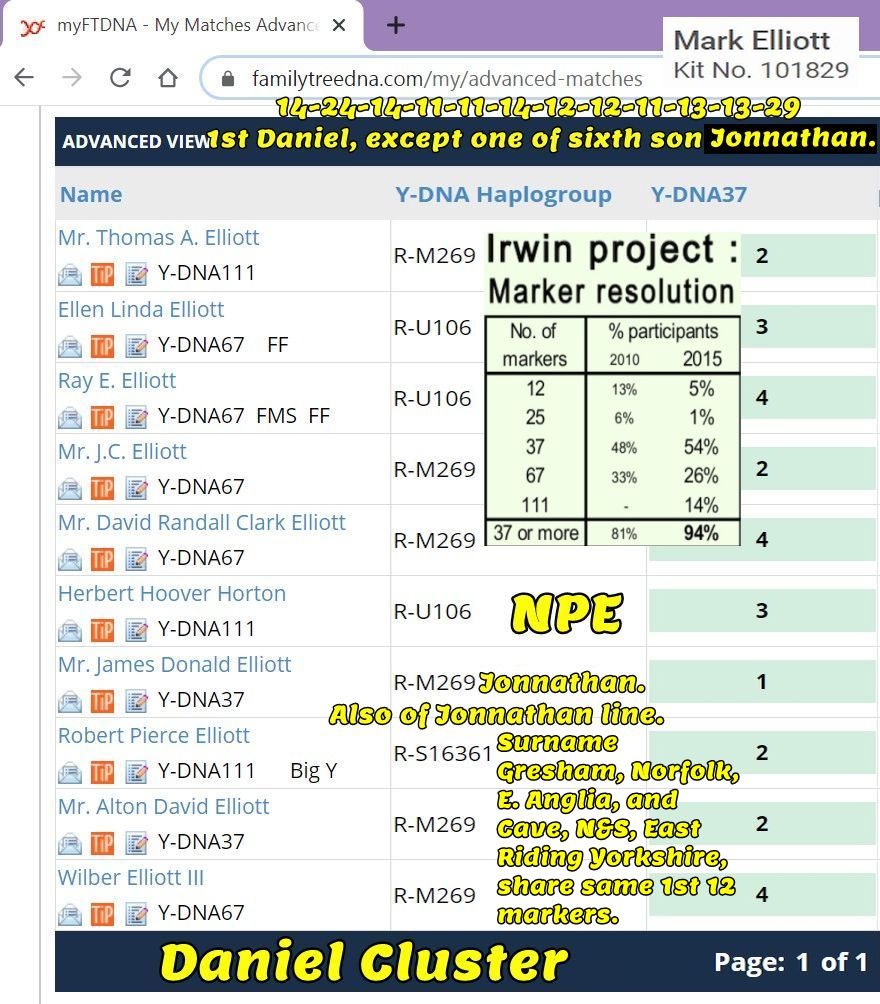
 https://elwald.com/wp-content/uploads/2019/06/A6724.jpg Yseq; Daniel son of Daniel tested positive for A6724+ Though did attempt finding SNP testing by FTDNA for A6722, Yseq was the testing lab making it available and tested positive for it. A Horton descended from an older brother of Daniel of the Testimony also tested positive for A6722, showing as well as I can surmise a mutation is in the next generation of the first son of Daniel which has the A6724 SNP instead of A6722,
https://elwald.com/wp-content/uploads/2019/06/A6724.jpg Yseq; Daniel son of Daniel tested positive for A6724+ Though did attempt finding SNP testing by FTDNA for A6722, Yseq was the testing lab making it available and tested positive for it. A Horton descended from an older brother of Daniel of the Testimony also tested positive for A6722, showing as well as I can surmise a mutation is in the next generation of the first son of Daniel which has the A6724 SNP instead of A6722,
Cathy Carley Yesterday at 2:13pm
http://freepages.rootsweb.com/~donegalstrongs/genealogy/armstrong.htm
Those Clendinnens, the Armstrong match also match that of the great Rich Rucker. He and I were kicked off of FTDNA Armstrong, Yet, I match a Rücker/Ruecker/Rucker.
Can you believe being kicked out of the FTDNA Armstrong blog, both Rich and myself, and he had such an excellent question. Chief has an ‘elwand’ on her arms, an Edinburgh standard of measuring length in 16th century Scotland and us Elwald were sometimes called Elwand, guess we could just measure. Ending up in Germany as ‘rücker’, as regulators. Guess regulators can measure. He’s some genealogical referencing. The non genetic genealogical scientist call it ‘spam’.
https://d3tije9h5o4l4c.cloudfront.net/social-photos/3212106?dpr=2&fit=max&h=408&w=590
https://d3tije9h5o4l4c.cloudfront.net/social-photos/3211961?dpr=2&fit=max&h=296&w=590
https://gorrenberry.com/wp-content/uploads/2015/09/Rucker-surname-distribution-1.jpg
https://gorrenberry.com/wp-content/uploads/2015/05/migration-path.jpg
https://gorrenberry.com/wp-content/uploads/2015/09/Elk-Elch-Elg.jpg
https://nvk.genealogy.net/map/1890:R%C3%BCcker,1890:Ewald
http://homepages.rootsweb.com/~clendin/Comparisonchart.htm
https://d3tije9h5o4l4c.cloudfront.net/social-photos/3525483?dpr=2&fit=max&h=412&w=590 https://gorrenberry.com/wp-content/uploads/2015/05/A1-Clade-Report.pdf https://www.electricscotland.com/webclans/dtog/elliot65.jpg by Sir Arthur of Redheugh-Stobs 28th Clan Elliot chief, Margaret only child is 29th chief. https://upload.wikimedia.org/wikipedia/en/4/43/Sasine_deed_1484_for_Robert_Elwald_%28Elliot%29%2C_Redheugh%2C_Larriston%2C_Hartsgarth.jpg Sasine/Deed has Crosar/Crozier as withnesses. A lot of Glendinning and Little towards the east where Thorlishope Elwald-Ellot migrated to have R-L193 Y-DNA.
The History of Liddesdale, Eskdale, Ewesdale, Wauchopedale and the …, Volume 1
By Robert Bruce Armstrong
Evia et Escia Scotis, Evsdail et Eskdail / Auct. Timotheo Pont, I. Blaeu Atlas of Scotland, 1654
Scottish notes and Queries Vol 11
2/6/2020 MSE
+ Crosier/Crozier R-L193
R1b-P312 > R1b-L21 > DF13 > L513 > L513 (L21>DF13>L513) & Z249 and Subclades L193…
Report on A1 Clade/R-L193
Brought to attention By; James V. Elliott;
Glendonwyn, the place name of Glendinning is used.
Elliott;
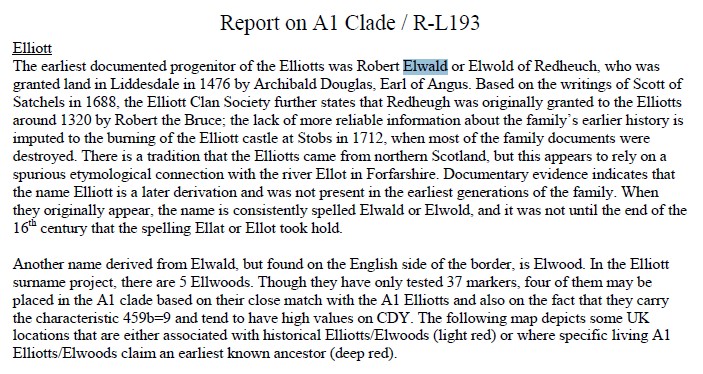
https://www.peopleofthebritishisles.org/
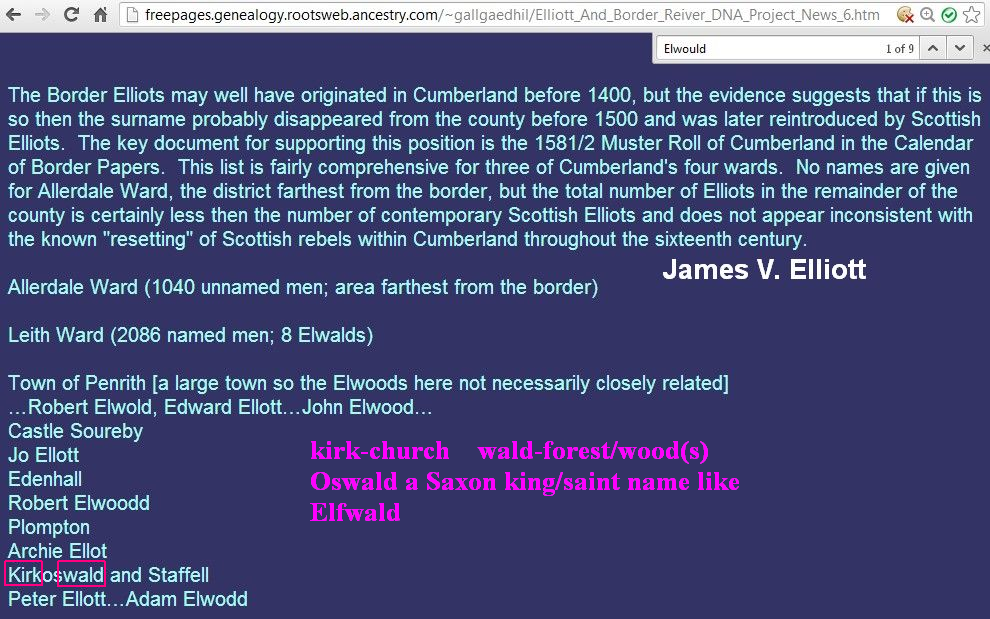

1484 Angus (ie Archibald ‘Bell the Cat’ Douglas V earl of Angus)
Heart of Archibald’s is next to Sir James Douglas, which carried the heart of Robert the Bruce, as added to the arms/shield of Sir James Douglas.
Walter Scott son of David Scott, of Buccleuch; Walter Ker of Cessfurd, Duke of Roxburghe, residence Floor Castle near Kelso. Rudolph Ker is his brother could be of the more recently but for left hand people Ferniehirst Castle. The Gledstanes landholders which sold land of Stobs to Gavin Ellot, and William Elwald, Goodman of Gorrenberry, my many great grandfather, of land of Gorrenberry, like the Armstrong’s land of Mangerton and part of Whitehaugh, acquired by the Duke of Buccleuch.
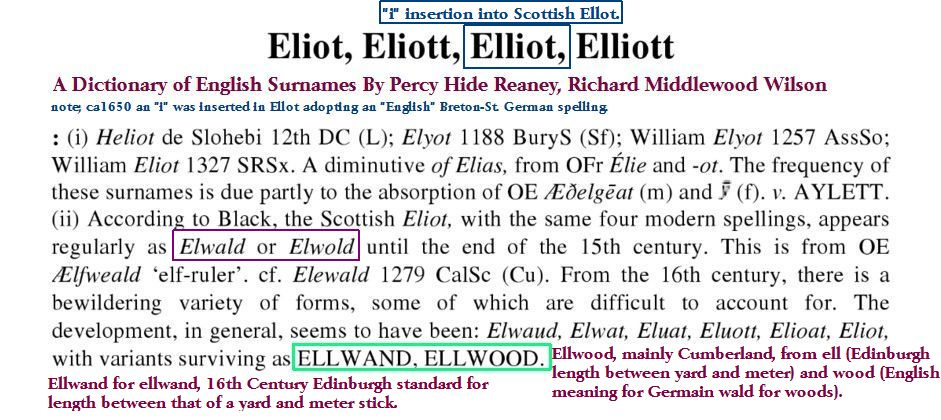

Note; name has different spellings with different origins, R-L193 is showing to be a significant origin. It is felt where R-L193 near the Dabatable Lands is an area of surname incubation about 1400 AD.
http://named.publicprofiler.org/
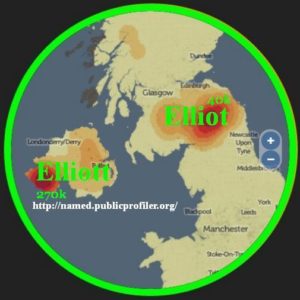

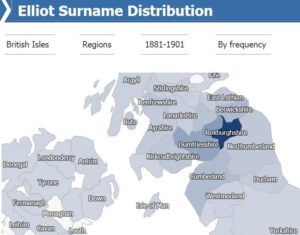
R-L513 Subclades FTDNA (L193)
http://www.therjhuntercollection.com/resources/muster-rolls-c-1630/search-muster-rolls/
Glenndinning;
http://named.publicprofiler.org/
forebears.io/surnames/Glendinning
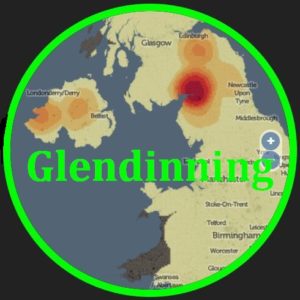
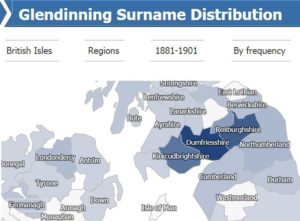


R-L513 Subclades FTDNA (L193)
Little;
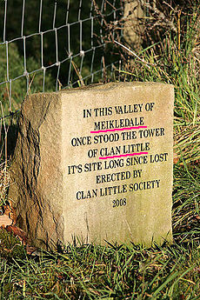
http://named.publicprofiler.org/
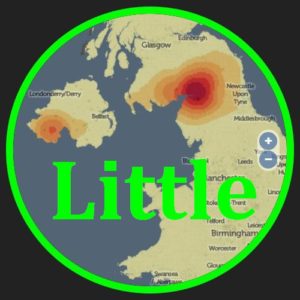
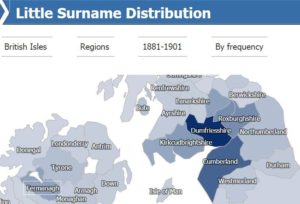
R-L513 Subclades FTDNA (L193)
Distribution patterns show a migration to County Fermanagh, Ulster Ireland which follows the history given by Robert Bell;
‘Sheep stealers from the north of England’: the Riding Clans in Ulster by Robert Bell
11/5/2017 MSE
St Clair DNA – R-L193 SNP Results
https://www.familytreedna.com/public/Sinclair?iframe=ycolorized
Steve St Clair; administrator. Above R-L193 groups.
R-L21>..>L1066;
https://www.familytreedna.com/public/Gresham_Grissom?iframe=yresults
+10/19/2019-05/14/2018 MSE
Muster Roll for Tullyhogue (Tullaghoge) 1610 Transcribed by Teena
Glendenning; https://gorrenberry.com/wp-content/uploads/2019/08/ballads-of-the-Border-Reivers..mp4 Etched in floor near the name Elliot, in and underpass near Carlisle Castle. Note at end of video under Wilson is etched the name Little.
Note the names Robert and William Steele, the Nixon are from Steel (steep sided contained stream), between Redheugh, and Larriston, Scotland.
Muster Roll for Tullyhogue (Tullaghoge) 1610
Transcribed by Teena
GLENDENNING was especially pleased that Dick ELLIOTT …
In above link; Dave CARLISLE of Shannon City…. (10km-6mi north of Mt Ayr on county line, population about 70). Please do not inform him that Gorrenberry was in on the rescue of Kinmont Willie.
note; James and John Somerville, are of Tullykelter, like the Daniel Elliott family is.
http://www.elwald.com/wp-content/uploads/2013/06/Tullykelter-to-America.pdf
Dick is my 1st cousin; Jack’s 2nd son next two Kirk and Karen twins also like Lois and Loren, oldest is Craig. These are names of the Scottish borderlands.
https://forebears.io/surnames/glendenning
In 1880 Ringgold County, Iowa, ranked second to Philadelphia, County, in number, and the highest in frequency of all counties in the United States for the surname Glendenning. They went to the same one-room Crownpoint School as the Elliott of Rice Township.
[Glendinning R. valley, where the Glendenning, living with Ellot are from which are of a region with my the Elliott, from about 5km (3mi) south of Mt. Ayr, Iowa, USA; named after Ayr, Scotland, where Bobby Burns is from; which wrote in the language of Scotland.]
Ulster Fermanagh, muster 1630, Magherbuy;
[Widow Hammelton,1500 Acres], Mark Ellot (note; Robert of line), No Arms.
11/24/2018 MSE
12/26/2018 MSE
Hawick Carlisle
https://named.publicprofiler.org/
‘Sheep stealers from the north of England’: the Riding Clans in Ulster by Robert Bell
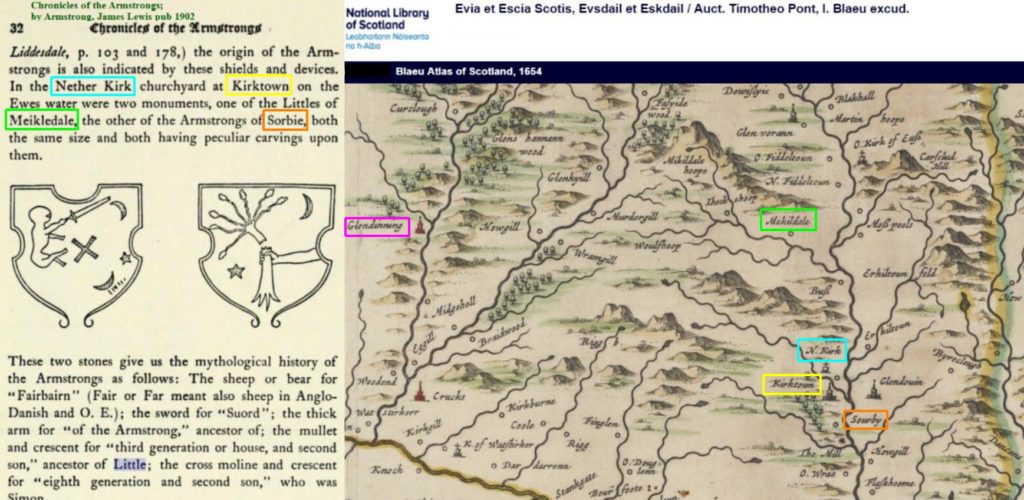 https://archive.org/details/chroniclesofarms00arms/page/32
https://archive.org/details/chroniclesofarms00arms/page/32
https://archive.org/details/chroniclesofarms00arms/page/300
9/2-3/2019 MSE
https://gilnockietower.co.uk/
9/4/2019 MSE
10/28/2019 MSE
Davidson Duff MacRae Proffitt Sinclair St. Clair L513 L193
https://named.publicprofiler.org/
11/22/2019 MSE
Douglas of Glendinning
According to the account given in Douglas’s Baronage, and also in Anderson’s Scottish Nation, Glendinning, formerly spelt Glendoning, anciently Glendonwyn, is a surname derived from ” the territory known of old by that name,” which comprehended ” a considerable district ” of Eskdale, Ewis, Liddesdale, and the west of Roxburghshire.The origin of the name Glendenning or Glendinning, is obviously from the lands of that name.
However it seems that it first came into prominence with William Douglas of Glendinning who was the second son of William Douglas, 1st Lord Douglas, 1057 AD.
The chart, an extract from a family tree of unknown provenance, shows a succession of William, Alexander, William.
Sources
Sources for this article include:
• Clan Douglas Association of Australia (CDAA) Newsletter #82, 2009.
The Glendinnings a Douglas sept
The Glendinnings are a sept of the Douglas Clan and the history of the name goes back to Adam de Glendonwyn who was alive during the reign of Alexander III of Scotland, circa 1286.
According to the account given in Douglas’s Baronage, and also in Anderson’s Scottish Nation, Glendinning, formerly spelt Glendoning, anciently Glendonwyn, is a surname derived from ” the territory known of old by that name,” which comprehended ” a considerable district ” of Eskdale, Ewis, Liddesdale, and the west of Roxburghshire.
An unidentified sourse states that the name originates from the lands of same name in Westerkirk in Dumfriesshire. But it goes on to say that, prior to 1286, a charter was granted by John Macgill of that Ilk to Adam de Glendonwyn of his part of the lands and baronies of Clifton and Mertobel in Roxburghshire. Sir Adam obtained a discharge of all bygone feu-duties from Archibald Douglas, lord of Galloway in 1313, and John of Glendonwyne and Symoun of Glendonwyne were two of the ‘borowis’ for the earl of Douglas’s bounds of the West March in 1398.
Educated men in Scotland spoke the language of their allies, the French, and many surnames developed based on place names – de Glendonwyn meaning of (or from) Glendonwyn.
Adam’s descendants became knights and substantial landholders, fighting alongside the Douglas clan leaders in their battles with the English and were often to be found offering themselves to English Kings as hostage for their countrymen’s good behaviour.
The clan grew (that is the followers who took the name Glendinning and who were not necessarily relations of the principal family) and ultimately began to spread – across the border to England, over to Ireland during the Plantation of Ulster in 1610 and on to the New Worlds, Scots being leaders in emigration.
The most common reasons for the earliest border crossings were raids to steal English sheep, cattle and horses. Some of these men, known as reivers, just never went home and were eventually accepted by the community they chose to settle in.
Margaret Douglas b c 1325, d by 7/1377 daughter of Sir John Douglas of Lothian & Agnes Monfode; niece of Sir William Douglas of Lothian – ancestor of the Douglases of Morton married in about 1342 Adam de Glendonwyn of Glendonwyn
Adam de Glendonewyn occupied Glendonwyn in 1341-42. About 1342 Adam married Margaret, daughter of Sir John Douglas of Lothian and his wife Agnes Monfode, a niece of Sir William Douglas of Lothian. Margaret born in about 1325, died before 1st August 1377. Her brother Sir James Douglas of Dalkeith, born about l330, was beloved “kinsman” of Robert II, King of Scotland.
In 1380 Sir Adam Glendonwyn was receiver of the Douglas revenues for Eskdale, and received grants of the lands of Brecallow, i.e. Barntalloch or Stapelgortoun.
Before 1383, Sir Simon Glendinning of Parton married Lady Mary Douglas, daughter of Archibald Douglas, 4th Earl of Douglas and Margaret Stewart, Lady of Galloway.
Sources for this article include:
• Clan Douglas Association of Australia (CDAA) Newsletter #82, 2009.
• Eskdale and Liddesdale Advertiser, 1879
http://www.douglashistory.co.uk/history/Septs/glendinning.htm
4/4/2020 MSE

